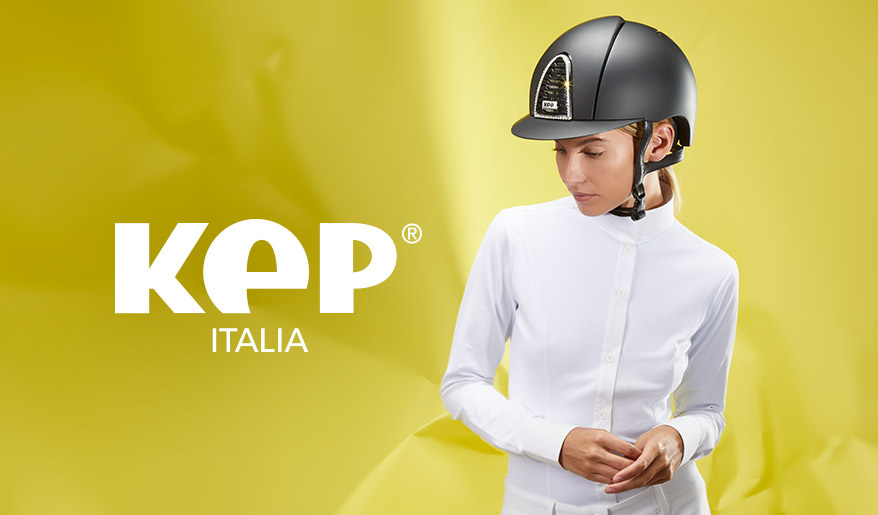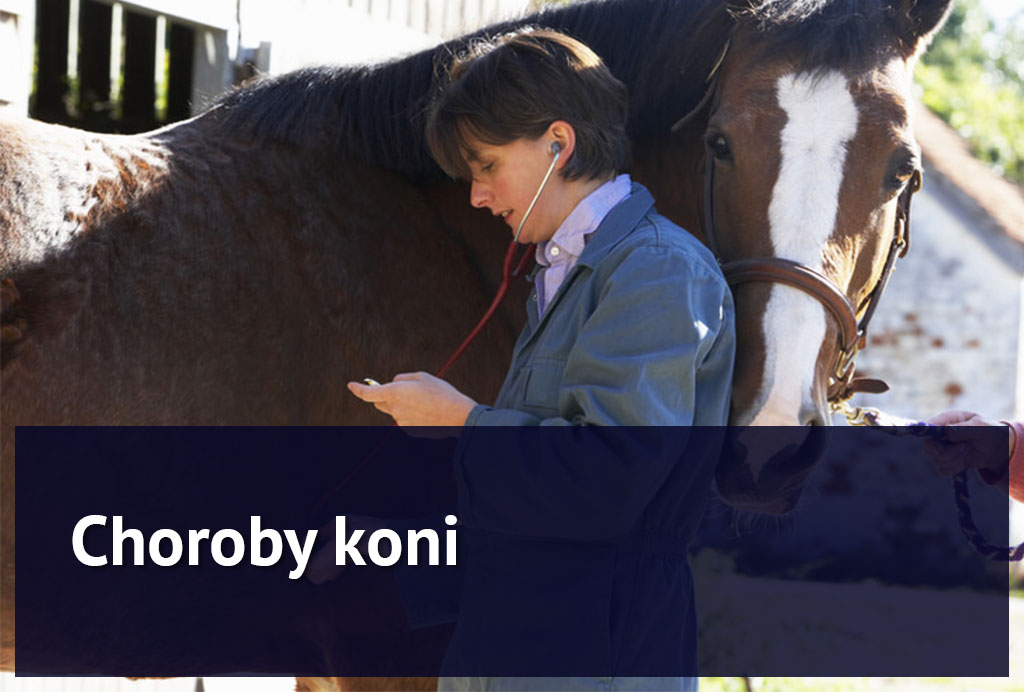
Koń to oczko w głowie każdego jeźdźca kochającego te wyjątkowe zwierzęta. Niestety, nieważne jak bardzo staramy się zadbać i otoczyć opieką swojego pupila, czasem zdarzają się sytuacje, które ciężko przewidzieć i na które nie mamy wpływu. Gdy coś zagraża zdrowiu naszego rumaka, a nawet jego życiu, zanim przybędzie weterynarz – pierwszej pomocy powinniśmy udzielić mu MY.
Konie niestety nie komunikują swego dyskomfortu głośnym płaczem. Jednakże patrząc uważnie na swego podopiecznego, nie powinno umknąć naszej uwadze jego niecodzienne zachowanie: nerwowość, apatia, niechęć do poruszania się czy po prostu smutne spojrzenie, a przecież z końskich oczu można wyczytać wszystko. Chcesz wiedzieć jakie są najczęstsze choroby koni? Co zrobić, jeśli zauważymy alarmujące objawy? Co zrobić zanim przybędzie weterynarz? O tym przeczytasz w poniższym artykule.
 źródło tła: lacollectemedicale.fr
źródło tła: lacollectemedicale.fr
1.Co można zrobić przed przyjazdem weterynarza? Sprawdź podstawowe parametry:
Tętno
Najlepiej (i najwygodniej) jest je mierzyć stojąc po lewej stronie konia i przykładając palec wskazujący i środkowy do jego tętnicy twarzowej, która znajduje się na wewnętrznej kości żuchwy na łuku ganaszy. Lekko ją przyciskając powinniśmy wyczuć puls. Jeśli nasz koń nie potrafi ustać spokojnie w miejscu i rusza głową - warto liczyć uderzenia tylko przez 10-15 sekund, mnożąc wynik przez 4 bądź 5. Innym dobrym miejscem do badania pulsu jest tętnica śródstopia, która przebiega przez tylną powierzchnię stawu pęcinowego, w okolicy trzeszczek pęcinowych. Tutaj też powinno się liczyć przez 15 sekund.
Kolejnym sposobem jest zmierzenie tętna przy użyciu stetoskopu, bądź innego miernika tętna, przykładając słuchawkę lub nadajnik do końskiego brzucha za jego przednią nogą, nieco wyżej poziomu guza łokciowego. Mierzymy tętno, pamiętając, że ilość uderzeń serca u dorosłego konia w ciągu minuty w stanie spoczynku powinna mieścić się w przedziale 30 - 44 ud./min.
Oczywiście istnieją różne odstępstwa od podanej powyżej normy, dlatego warto jest zmierzyć parokrotnie tętno konia, kiedy jest on w dobrej formie, by poznać jego naturalne tętno spoczynkowe. Pamiętajmy, że warto robić to w boksie, gdzie koń czuje się bezpiecznie i gdzie nie ma aż tylu pobudzających go bodźców.
Podniecenie, praca czy zachorowanie zwiększają wynik tętna nawet do 200 uderzeń/min. Kilkudniowe źrebaki mają wyższe tętno spoczynkowe i wynosi ono 80-120 uderzeń na minutę. Natomiast już półroczne źrebię ma tętno dwa razy szybsze od konia dorosłego tj. 60 - 80 ud./min.
Puls spoczynkowy u dorosłego konia, powyżej 60 uderzeń na minutę jest niepokojący, a więcej niż 80 uderzeń alarmujący. Przyspieszone tętno można zaobserwować w wypadku gorączki, ostrego bólu, udaru słonecznego, kłopotów z sercem, kolki (im szybsze, tym z cięższym przypadkiem mamy do czynienia). Wolniejszy puls pojawia się w sytuacji, gdy zwierzę przebyło wycieńczającą chorobę, zatrucie bądź jego organizm jest wychłodzony lub występują kłopoty z sercem. Tętno nieregularne można zaobserwować wypadku niewydolności układu krążenia.
Oddech
Norma u dorosłego konia wynosi od 10 do 12 oddechów na minutę w stanie spoczynku (niektóre źródła podają nawet 12-20 oddechów na minutę). Tak jak w przypadku tętna, oddech naszego pupila również warto zmierzyć kilkukrotnie w czasie, w którym wiemy, że nic mu nie dolega, by poznać jaka jest normalna ilość jego oddechów.
W czasie ciężkiej pracy ilość oddechów może wzrosnąć nawet do 180 na minutę. Niektóre zwierzęta oddychają szybciej, chociaż płycej w czasie upałów, dlatego przyspieszony oddech nie zawsze oznacza u nich chorobę.
Jeśli chcemy policzyć oddechy naszego konia najlepiej jest to zrobić, przykładając rękę, bądź stetoskop do słabizny - w zagłębieniu za żebrami konia przed guzem biodrowym. Stetoskop można także przystawiać z przodu szyi, ok. 15 cm poniżej gardła.
Innym sposobem jest także obserwacja nozdrzy lub ustawianie dłoni przed nimi, wyczuwając w ten sposób oddechy. Ten pomiar jednakże nie jest tak dokładny, ponieważ przykładowo zwierzę zamiast "normalnie" oddychać, może zacząć obwąchiwać nam dłoń.
Oddech przyspieszony występuje w przypadku gorączki, infekcji, bólu, udaru słonecznego lub gdy została zaburzona gospodarka elektrolitowa organizmu. Pamiętajmy także, że również upał i wzmożona wilgotność przyczynia się do zwiększonej ilości oddechów na minutę. Zwolniony oddech można zaobserwować w przypadku wychłodzenia organizmu, zapaści lub reakcji na podane lekarstwa.
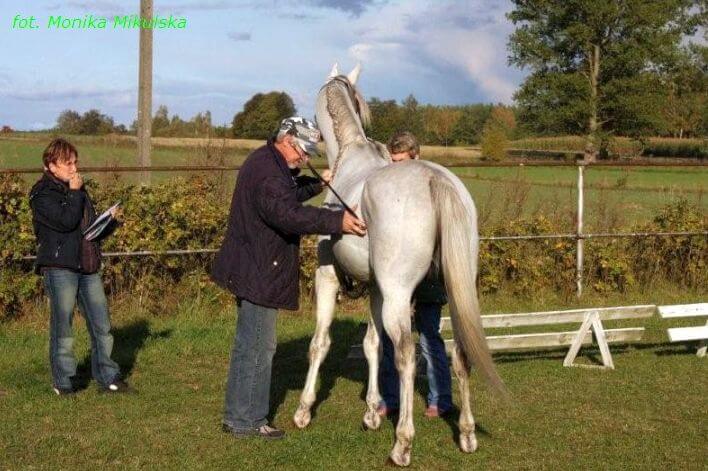
Temperatura
Temperatura u zdrowego konia wynosi 37,7ºC – 38,5ºC (niektóre źródła podają górną wartość 38,9ºC), a więc jest zdecydowanie wyższa od temperatury ciała człowieka. Pamiętajmy, że temperatura końskiego ciała zmienia się w zależności od pory dnia oraz panującej pogody. Upał, podniecenie oraz wyczerpujący trening mogą ją podwyższyć nawet o 2 stopnie Celsjusza.
W jaki sposób dokonać pomiaru temperatury? Wykorzystujemy do tego specjalny termometr, który umieszczamy w końskim odbycie. Przed pomiarem temperatury zdezynfekowaną końcówkę termometru należy posmarować cienką warstwą wazeliny. Termometr ostrożnie wsuwamy w odbyt na głębokość ok. 5 cm. Warto do tej czynności poprosić drugą osobę o przytrzymanie i uspokajanie konia, by ten nie wiercił się podczas pomiaru.
Temperatura powyżej 39ºC powinna nas zaalarmować, ponieważ może to być objawem np. infekcji lub ropnia. Temperatura poniżej 37ºC wynikać może z utraty dużej ilości krwi, wygłodzenia bądź zapaści.
![horse-therm Termometr dla konia, źródło: goodwoods.com.au [embed][/embed]](https://cdn.equishop.com/img/blog-archive-pl/2015/10/horse-therm.jpg)
2.Niepokojące objawy
Kał i mocz
U zdrowego konia barwa kału może mieć różne odcienie - od brązowozielonej do brązowożółtej (w zależności od proporcji spożytych zielonek do ilości pozostałych pasz). Kał powinien być wilgotny i łatwo się rozpadać w kontakcie z podłożem. Mocz powinien być lekko mętny, w kolorze żółtej gliny do żółtobrązowego. Dzienna ilość wydalanego moczu wynosi ok. 10l.
Kał zbyt twardy lub zbyt miękki o przykrym zapachu, o barwie jasnożółtej lub ciemnobrązowej oraz mocz o jasnożółtym zabarwieniu - występują, gdy dieta konia jest bardzo bogata w białko. W takim przypadku oraz gdy w końskich odchodach (moczu oraz kale) pojawia się krew powinniśmy dostarczyć ich próbki do badania konia. Z pewnością pomoże nam to odnaleźć przyczynę odchyleń od normy.
Apetyt
Zdrowy koń spożywa paszę często, ale w małych ilościach. Normalnym widokiem jest szukanie przez konia karmy. Konie powinny posilać się powoli, gdyż łapczywe zjadanie paszy jest wynikiem stresującej zwierzę obecności innych koni lub ludzi. Dodatkowo zbyt szybkie pobieranie paszy może mieć przykre dla zdrowia konia konsekwencje.
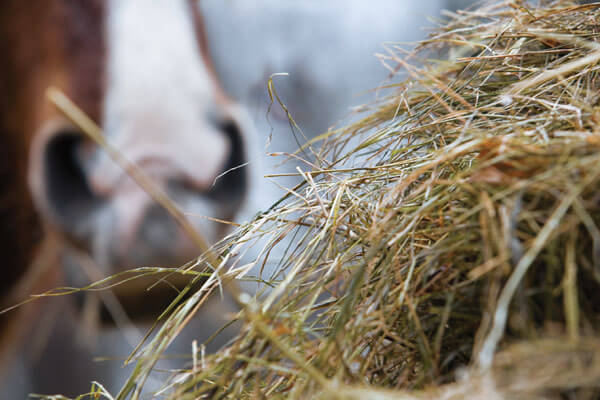
Objawem choroby może być brak apetytu - niechęć do spożywania pokarmów, bądź niedojadanie paszy treściwej np. owsa. Wynikać to może z kłopotów związanych z uzębieniem, skaleczeń jamy ustnej lub chorób układu pokarmowego. Po zaobserwowaniu problemów ze spożywaniem pokarmów warto zwrócić uwagę na objawy sugerujące wrzody u konia.
Uwaga!
Niektóre konie są bardzo wrażliwe na jakość paszy oraz sposób jej podawania. Słaba jakość pożywienia lub nieczystości w żłobie także mogą przyczynić się do braku apetytu. Brak dostępu do odpowiedniej ilości wody również hamuje apetyt.
Dziąsła
Dziąsła u zdrowego zwierzęcia powinny mieć kolor zaczynając od jasnoróżowych aż do białoszarych. Białe dziąsła wskazują na anemię, niebieskie lub brązowoszare na zatrucie. Ukrwienie sprawdza się poprzez chwilowy nacisk kciukiem na górne bądź dolne dziąsło. W miejscu nacisku tuż po zabraniu kciuka powstaje biała plamka, która powinna zniknąć po upływie dwóch sekund. Jeśli utrzymuje się dłużej niż pięć sekund świadczy to o krytycznym niedokrwieniu, co może oznaczać zapaść.
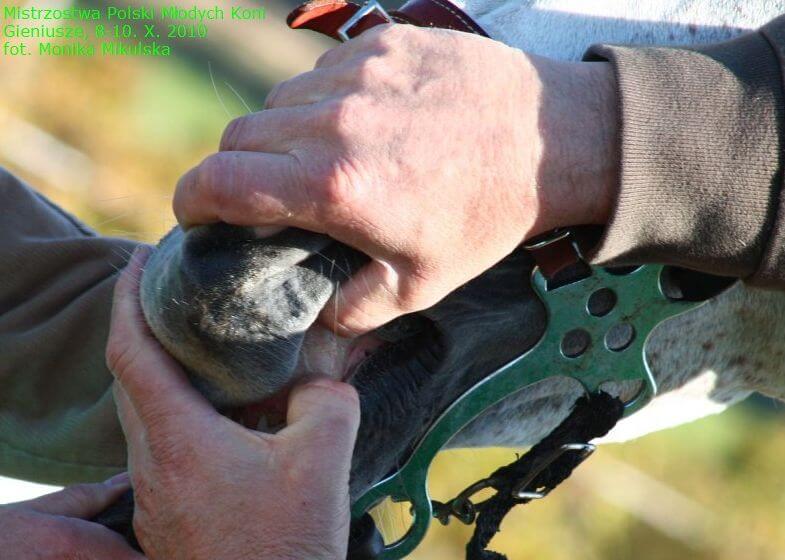
Inne objawy
Oczywistym jest, że wszelkie odstępstwa od normy takie jak:
zachowanie - zwiększona nerwowość lub przeciwnie - ospałość konia, apatia
oczy - łzawienie, obrzęk lub zamknięcie powiek, zaczerwienienie, światłowstręt
nozdrza - różnego rodzaju nieprzezroczyste wycieki i wydzieliny
pysk - otarcia, skaleczenia, zły stan uzębienia
oddech - zakłócony napadami kaszlu, duszność objawiająca się rozszerzonymi nozdrzami
skóra - wrażliwa na dotyk, uszkodzona, z widocznymi zmianami, intensywne pocenie
kopyta - jedno cieplejsze od pozostałych, przebarwienia lub ciemne plamy na podeszwie
ścięgna - deformacje, wrażliwość na dotyk, podwyższona ciepłota
ruch - kulawizna, niechęć do ruchu, niechęć do wstania, nadmierne tarzanie, pokładanie
... i inne niecodzienne zachowania i objawy, powinny wzbudzać naszą podejrzliwość. Warto również obserwować jak śpi koń - czy często śpi w pozycji stojącej, czy przybiera pozycje leżącą i ile czasu poświęca na odpoczynek.
Nie wahajmy się nigdy nad słusznością wezwania weterynarza. Czasami warto być "nadgorliwym" i reagować na każdą niepokojącą zmianę u naszego zwierzęcia. Nigdy nie podejmujmy jedynie leczenia na własną rękę - stan choroby może nie tylko się nie zmienić, ale nawet się pogorszyć.
3.Najczęstsze choroby koni
Konie to zwierzęta obdarzone umiejętnością szybkiej reakcji i posiadające silny instynkt nagłej ucieczki. Są one również podatne na różne urazy wynikające z przeciążenia wysiłkowego oraz wiele chorób powszechnie, jak i rzadko spotykane. Ochwat, gruda, grypa, wrzody czy kolka to najczęstsze choroby koni. Pierwsze objawy to apatia, nerwowość czy nieobecny, szklisty wzrok. W dzisiejszym artykule przedstawimy najczęstsze urazy i choroby koni oraz ich krótką charakterystykę:
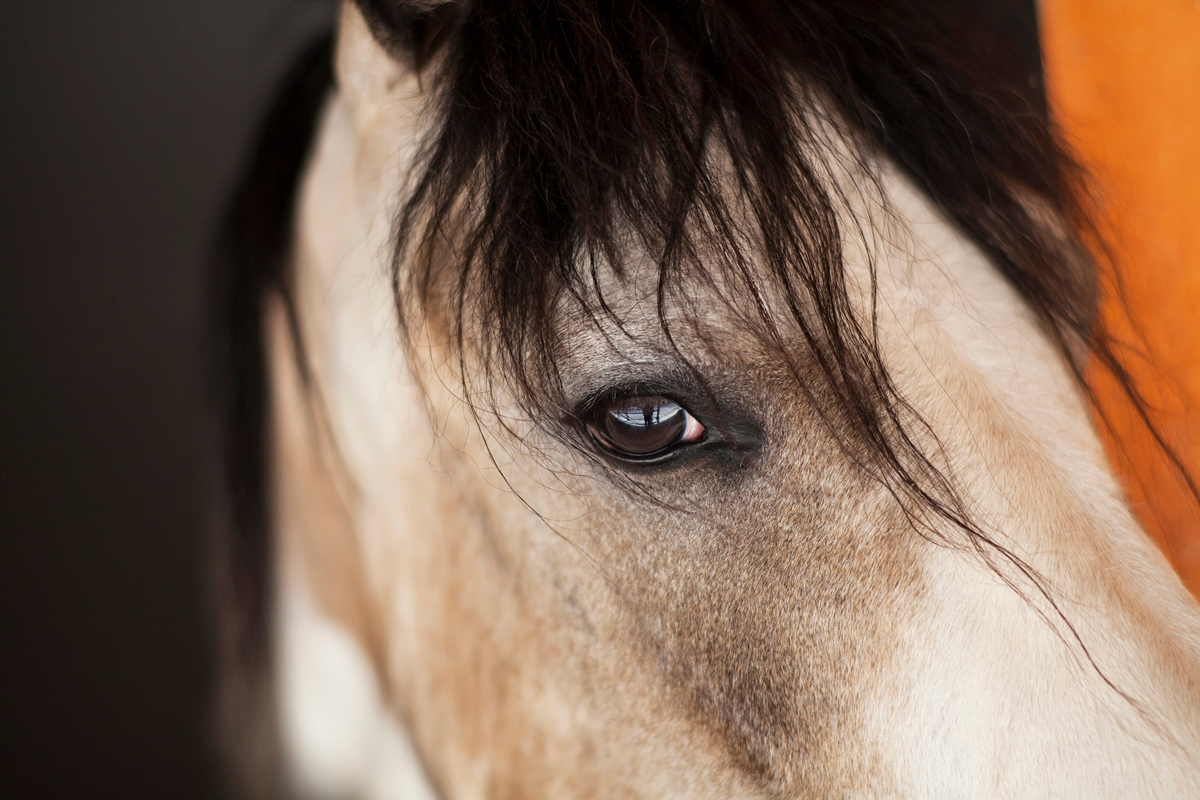
Choroby oczu:
Owrzodzenie rogówki
Do owrzodzenia rogówki może dojść na skutek urazu mechanicznego lub zakażenia. Pojawia się ból, łzawienie, zamglenie powierzchni rogówki oraz widoczna jest szpara powiekowa. Należy zabezpieczyć konia przed ostrym światłem. Najczęściej zaleca się leczyć owrzodzenie przez podanie antybiotyku lub zabieg chirurgiczny.
Podwinięcie powieki
Jest to wrodzone schorzenie u źrebiąt, któremu towarzyszy łzawienie i podrażnienie rogówki. Oczy konia są zamknięte a powieka podwinięta. Zaleca się tymczasowe założenie szwów, aby odwinąć powiekę.
Ślepota miesięczna (nawracające zapalenie błony naczyniowej)
Przyczyną pojawienia się ślepoty miesięcznej jest zapalenie ciała rzęskowego i tęczówki spowodowane reakcją odpornościową na zarazki. Objawia się ostrym bólem, zwężeniem źrenic, łzawieniem, zacieśnianiem powiek oraz stanem zapalnym spojówek i tęczówki. Charakterystyczna jest mleczno-biała ciesz w tylnej komorze oka.
Zaćma
Jest to zmętnienie soczewki, które może być wrodzone u źrebiąt lub nabyte u dorosłych koni poprzez przebyte choroby oczu i urazy mechaniczne. Najczęściej leczenie polega na usunięciu chorej soczewki.
Zapalenie rogówki
Do zapalenia może dojść w wyniku urazu mechanicznego lub zakażenia. Rogówka jest obrzęknięta i widoczne jest jej mleczno-białe zmętnienie. Dodatkowo występuje kurcz powiek, łzawienie, zaczerwienienie i podrażnienie spojówek.
Zapalenie spojówek
Powstaje na skutek infekcji i objawia się widocznym zaczerwienieniem oka, obrzękiem powiek, nadwrażliwością na światło, wydzielaniem przeźroczystej wydzieliny lub śluzu i ropy. W leczeniu stosuje się najczęściej maść do oka z antybiotykiem.
Choroby uszu:
Brodawczyca małżowin usznych
Widoczne są narośla po wewnętrznej stronie uszu wywołane wirusem. Leczenie może polegać na usunięciu brodawczaków i stosowaniu maści przeciwzapalnych. Zaleca się również ochronę uszu podczas lata.
Świerzb uszny (Otodectes cynotis)
Wywołany jest przez świerzbowce i objawia się silnym podrażnieniem zaatakowanych obszarów, ocieraniem i drapaniem się konia. Leczenie odbywa się poprzez użycie środka pasożytobójczego do uszu.
Zapalenie ucha zewnętrznego
Do zapalenia może dojść na skutek infekcji bakteryjnej, grzybiczej lub utknięcia ciała obcego w przewodzie słuchowym konia. Ucho jest obolałe i może wydzielać się ropa. Koń pociera zainfekowanym uchem, potrząsa głową i może ją przechylać na jedną stronę.
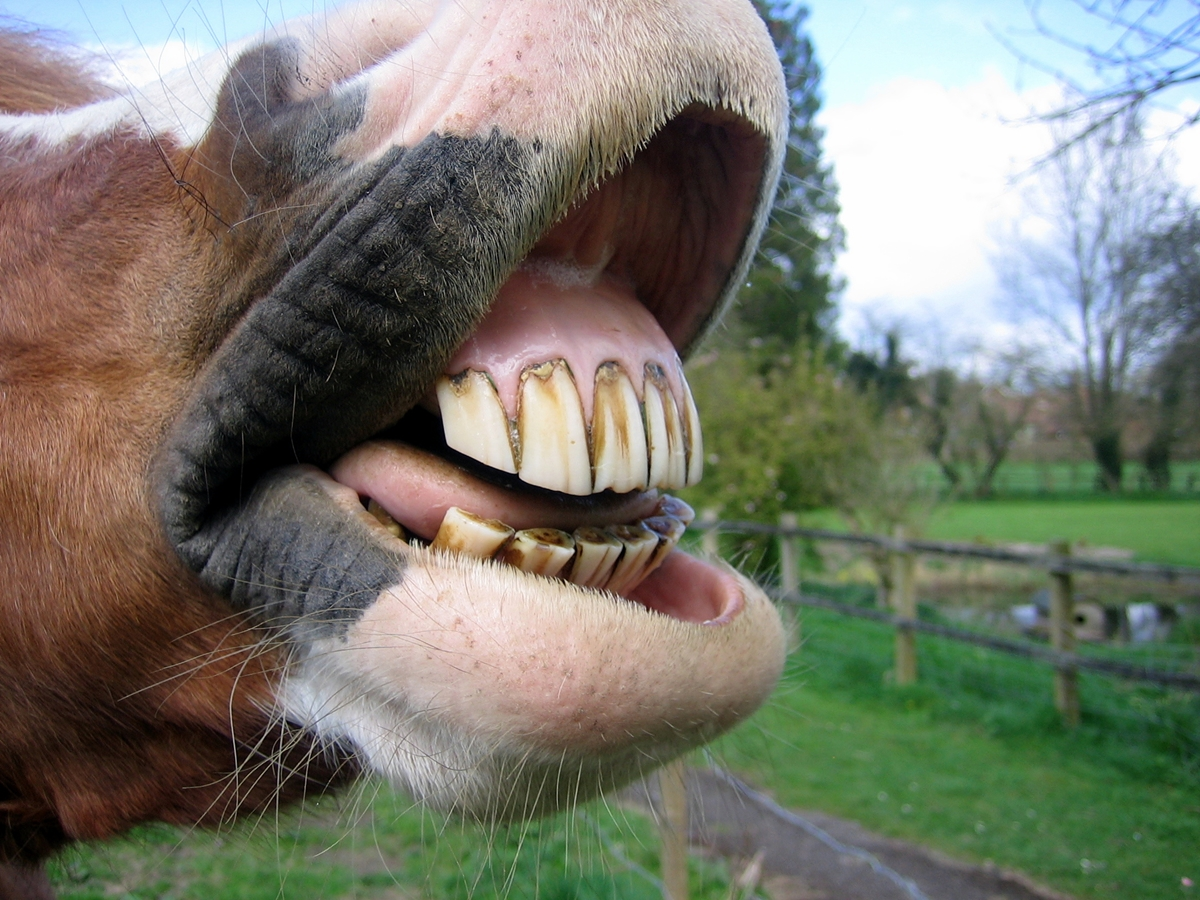
Choroby zębów i kości trzewioczaszkowych:
Najady
Jest to obrzęk tkanek podniebienia twardego konia w okolicy za górnymi siekaczami. Najczęściej występuje u młodych koni, które zaczęły proces wyrzynania się zębów, zwłaszcza u osobników chorych lub osłabionych.
W przypadku wystąpienia przetrwałego zęba mlecznego dochodzi do uciskania położonego pod nich zęba stałego. Możliwe objawy to: nadmierne ślinienie, utrudnione pobieranie pokarmu lub wypadanie pożywienia podczas żucia. Zaleca się usunięcie korony zęba mlecznego.
Są to szczątkowe zęby przedtrzonowe zalegające bezpośrednio przed zębami przedtrzonowymi. Konie posiadające wilcze zęby często mają problem z przyjęciem wędzidła, jednak po ich usunięciu objawy powinny szybko ustąpić.
Zapalenie tkanek okołowierzchołkowych zęba
Narażone na nie są konie starsze, z wadami zgryzu i nieprawidłowo przeżuwające. Obserwuje się spadek formy konia, nieprzyjemny zapach wydobywający się z jamy ustnej, problemy z pobieraniem i przeżuwaniem pokarmu, a także obecność niestrawionych ziaren w kale.
Zgryz karpiowaty
Jest to wrodzona wada zgryzu polegająca na wysunięciu górnej szczęki nad dolną.
Zgryz szczupaczy
Wrodzona wada zgryzu w której dolna szczęka wysunięta jest przed górną szczękę. W przypadku wyraźnej wady u źrebięcia może wystąpić problem z pobieraniem pokarmu i konieczna może być eutanazja.
Odontoklastyczna resorpcja i hipercementoza zębów (EOTRH)
Jest to bolesne schorzenie dotyczące siekaczy oraz kłów koni. Niekiedy może obejmować również zęby przedtrzonowe oraz trzonowe. W miarę postępu choroby, zapaleniu ulegają więzadła przyzębia, zębodół oraz miazga, co prowadzi do utraty stabilności zęba, powstawania przetok i zwiększenia ryzyka złamania.
Choroby mózgu:
Gorączka zachodniego Nilu
Do zachorowania zachodzi na skutek zarażenia wirusem przenoszonym przez ptaki i komary. Chory osobnik przejawia postępujące osłabienie oraz zaburzenia koordynacji ruchowej. Występuje również drżenie mięśni, brak apetytu, przyciskanie głowy, pozorna utrata wzroku oraz przemieszczanie się bez celu. W ostrym stadium choroby może dojść do nadpobudliwości, śpiączki i ostatecznie śmierci konia.
Hipoplazja móżdżku
Jest ona najczęściej spotykana u źrebiąt rasy arabskiej. Dochodzi w niej do zaburzeń równowagi i zapaści na skutek degeneracji komórek móżdżku.
Japońskie zapalenie mózgu i rdzenia koni
Jest to choroba wirusowa mózgu i rdzenia koni występująca na Dalekim Wschodzie. Wirus rozprzestrzenia się przez ptaki i owady. W pierwszej fazie choroby pojawia się gorączka, po której obserwuje się postęp nerwowych objawów, takich jak: nerwowość, pobudzenie, zapętlenie ruchowe, wpadanie na nieruchome przedmioty i utratę koordynacji ruchowej.
Padaczka
W początkowej fazie choroby widoczne są: szklisty, nieobecny wzrok konia, drżenie uszu i ogona, a nawet wspinanie się. Upadkowi konia towarzyszy drżenie nóg wyprostowanych nóg, a następnie dochodzi do stopniowego rozluźnienia i okresowej utraty przytomności.
Pierwotniacze zapalenie mózgu i rdzenia koni (EPM)
Zapalenie wywołane jest przez pierwotniaki Sarcocytis neurona. Dochodzi do porażenia warg lub uszu, opadania powiek, trudności z przeżuwaniem i połykaniem. Niekiedy obserwuje się trudności w utrzymaniu równowagi lub porażenie.
Toksoplazmoza
Objawy podobne są do wyżej opisanego pierwotniaczego zapalenia mózgu i rdzenia koni. Spowodowana jest spożyciem paszy zanieczyszczonej odchodami kotów zarażonych pierwotniakiem Toxoplasma gondii. Nie istnieje skuteczne leczenie koni chorych na toksoplazmozę.
Wenezuelskie zapalenie mózgu i rdzenia
Występuje podwyższenie temperatury, problemy neurologiczne i zaburzenia koordynacji. Wirus przenoszony jest przez ptaki i komary. Jest występowanie obserwuje się na terenie Ameryki Południowej i południowych stanów USA.
Wirusowe zapalenie mózgu i rdzenia koni
Wirus przenoszą ptaki i komary. U chorego osobnika najpierw pojawia się gorączka, następnie dochodzi do objawów neurologicznych, nietypowych zachowań i problemów z koordynacją. Śmiertelność choroby wynosi do 80%.
Wschodnie zapalenie mózgu i rdzenia koni
Objawy podobne do wirusowego zapalenia mózgu i rdzenia koni. Dotyczy terenów wschodnich stanów USA. Brak swoistego leczenia, jednakże są dostępne szczepionki.
Zachodnie zapalenie mózgu i rdzenia kręgowego
Objawy tak jak w przypadku wirusowego zapalenia mózgu i rdzenia koni. Sposób rozprzestrzeniania się przez ptaki i komary. Obecne na terenie zachodnich stanów USA.
Urazy mózgu
Do urazu mózgu może dojść na skutek silnego uderzenia, zwłaszcza w okolicy potylicy konia. Koń może przejawiać zaburzenia koordynacji o różnym stopniu nasilenia, zataczać się, krwawić z nozdrzy lub uszu (przy np. pęknięciu czaszki), mieć otępiały wzrok i problemy z równowagą.
Choroby układu oddechowego:
Dychawica świszcząca
Objawia się charczeniem lub świszczeniem konia przy wdychaniu powietrza. Przyczyną jest niewłaściwe funkcjonowanie lewego nerwu krtaniowego powrotnego. Leczenie obejmuje zabieg chirurgiczny w celu usunięcia kieszonki krtaniowej lub odciągniecie chrząstek nalewkowatych.
Krwiak małżowin sitowych
Początek choroby przejawia się krwotokiem z jednego nozdrza, a następnie obserwuje się głośne oddychanie oraz wydobywanie się nieprzyjemnego zapachu z pyska konia.
Krwotok z nozdrzy
Widoczne jest krwawienie z nozdrzy konia, może być spowodowane krwotokiem płucnym, zakażeniem lub chorobą nowotworową.
Odma worka powietrznego
Jest to deformacja powietrzna, obrzęk za żuchwą konia. Może występować po jednej lub obydwu stronach.
Polipy w jamie nosa
Obserwuje się widoczną, miękką narośl w przewodzie nosowym konia. Słyszalne są szmery podczas oddychania, wyczuwalny jest przykry zapach oddechu oraz towarzyszy mu wydzielina lub krwawienie.
Przemieszenie podniebienia miękkiego
W przypadku przemieszczenia podniebienia miękkiego słyszalne są odgłosy bulgotania, przypominające dławienie się. Przypuszcza się, że jego występowanie związane jest z wielkością nagłośni oraz pracą mięśni gardła.
Zapalenie worków powietrznych
Podczas zapalenia wydziela się ropa z jednego lub obydwu nozdrzy, występuje problem z przełykaniem i obrzęk kąta żuchwowego. Może być spowodowane infekcją bakteryjną lub grzybiczą.
Zapalenie zatok
Towarzyszy mu pojawienie się gęstej wydzieliny z nosa lub oczu i obrzęk tych obszarów. Zapalenie spowodowane może być przebytą infekcją dróg oddechowych lub chorobą uzębienia.
O podłożu alergicznym:
Choroba zapalna dróg oddechowych (IAD)
Dotyczy koni trzymanych w sposób ciągły w stajniach. Objawia się kaszlem, wydzieliną z nosa, spadkiem kondycji i widocznym śluzem w badaniu endoskopowym. Podejrzewa się, że przyczyną jest częsta ekspozycja na kurz.
Nawracająca choroba obturacyjna koni (RAO) dawniej COPD
Występuje przewlekły kaszel, świszczący oddech, problemy z nabraniem tchu i spadek kondycji. Na brzuchu widoczna jest "linia wdechu". RAO spowodowane jest reakcją alergiczną na roztocza i pleśń wdychane podczas pobytu w stajni lub spożywania zepsutej żywności.
O podłożu bakteryjnym:
Zapalenie opłucnej
Schorzenie to zwykle towarzyszy zapaleniu płuc. Objawia się gorączką, brakiem apetytu, apatią, płytkim i przyspieszonym oddechem, któremu towarzyszy charczący odgłos dochodzący z klatki piersiowej.
Zapalenie oskrzeli
Pojawić się może po przebytej infekcji wirusowej lub innym zakażeniu. Koń cierpi przez brak tchu, ma podwyższoną temperaturę i przewlekły kaszel. Oddech jest płytki, a w płucach słyszalne są szmery.
Zapalenie płuc
Zapalenie płuc powodują bakterie, różne wirusy i zarazki. Obserwuje się zanik apetytu, przyspieszony oddech, gorączkę, przewlekły kaszel i spadek kondycji.
Choroby układu krążenia:
Choroby naczyń krwionośnych:
Anemia
Niski poziom hemoglobiny we krwi spowodowany jest najczęściej przez ostry lub przewlekły krwotok, niedobory kwasu foliowego lub stres. Objawia się osłabieniem wydajności, apetytu i jakości sierści. Następnie dochodzi do bladości śluzówek i wyraźnego osłabienia.
Krwiak
Jest to widoczny obrzęk, który powstał gwałtowanie w mięśniach lub pod skórą. Do powstania krwiaka najczęściej dochodzi na skutek silnego uderzenia, kopnięcia lub wpadnięcia na np. ogrodzenie. Leczenie koni u których pojawił się krwiak polega na chłodzeniu miejsca zimnymi okładami, a po zaleczeniu zaleca się nacięcie i odsączenie krwiaka.
Choroby serca:
Arytmia
Są to zaburzenia rytmu serca. Brakujące uderzenia oznaczają opuszczenia od 1-3 uderzeń odbywające się podczas regularnego schematu. Migotanie przedsionków to nieprawidłowość pracy serca polegające na zaburzeniu rytmu przedsionków, co skutkuje dostarczaniem niewystarczającej ilości krwi do komór.
Szmery sercowe
Powstają w wyniku geometrii zastawek. Niektóre zmiany mogą mieć charakter progresywny i obniżać potencjał wysiłkowy konia. Mogą być wrodzone lub powstać na skutek choroby niedomykania zastawek.
Zapalenie mięśnia sercowego
Stan zapalny mięśnia sercowego może być spowodowany różnymi wirusami, jednak najczęściej powoduje go wirus końskiej grypy. Obserwuje się spadek kondycji, zaburzenia koordynacji skurczy serca przez węzeł zatokowo-przedsionkowy i arytmię. Zachorowanie wiąże się z ryzykiem zawału.
Choroby układu limfatycznego:
Obrzęk zastoinowy kończyn
Najczęściej dotyczy koni trzymanych w stajni. Pojawia się obrzęk wypełniony płynem w dolnych partiach kończyn, w okolicy pod nadgarstkiem i stawem skokowym. Leczenie koni z tym schorzeniem polega na zapewnieniu odpowiedniej dawki ruchu.
Zapalenie naczyń chłonnych
Zapalenie objawia się infekcją górnych naczyń chłonnych w kończynach, ciepłym i bolesnym obrzękiem. Dodatkowo pojawia się gorączka lub podwyższenie temperatury oraz ostra kulawizna. Do zapalenia dochodzi na skutek zakażenia rany lub grudy.
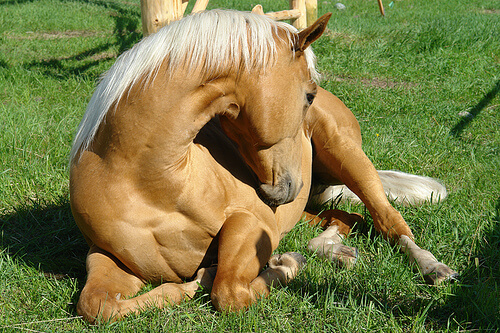
Choroby układu pokarmowego:
Choroby ostre:
Biegunka
Jest to objaw towarzyszący wielu schorzeniom, w przypadku których kał konia staje się bardziej lub całkowicie płynny w porównaniu do zdrowego kału. Długo utrzymująca się biegunka jest stanem niepokojącym i powinna być skonsultowana z lekarzem weterynarii.
Kolka u konia, zwana również morzyskiem, to zespół symptomów wskazujących na ból w jamie brzusznej, często wywołany przez różne choroby przewodu pokarmowego (w tym nieodpowiednia dieta). Obejmuje ona wszystkie choroby żołądka, jelit, układu moczowo-płciowego, które powodują ból. W każdym przypadku wystąpienia kolki istnieje bezpośrednie zagrożenie życia i konieczna jest pilna interwencja weterynarza.
Ostre zapalenie okrężnicy i jelita ślepego
Jest to choroba śmiertelna dla koni dorosłych i najczęściej związana jest ze stresem. Często zaczyna się silnym stanem depresyjnym konia oraz odbarwieniem śluzówek. We wczesnym stadium choroby obserwuje się przyspieszone tętno, podwyższoną temperaturę, a po wystąpieniu wstrząsu nagły spadek temperatury poniżej normy.
Rozrostowe zapalenie jelit
Schorzenie źrebiąt (3-12 miesięcy) i koni dorosłych wywoływane przez bakterie Lawsonia intracelluraris poprzez spożycie zainfekowanego odchodami dzikich zwierząt pokarmu. Najczęstszym jej objawem jest biegunka, kolka, spadek wagi, obrzęk okolic brzucha i niekiedy opuchlizna górnych partii kończyn oraz głowy.
Salmonelloza
Jest ona wywołana zakażeniem bakterią Salmonella. Może występować jako schorzenie pierwotne lub wtórne po leczeniu antybiotykami. Pierwsze objawy to silna biegunka, widoczny dyskomfort, kolka, wysoka temperatura, przyspieszone tętno i oddech. W wyniku przedostania się endotoksyn do organizmu może dojść do silnego wstrząsu, a następnie do posocznicy.
Zadławienie
Zadławienia polega na utknięciu ciała obcego w przełyku. Podczas zadławienia obserwuje się wypływającą z nosa i pyska konia treść pokarmową, głośne charczenie i niepokój zwierzęcia. Dochodzi do niego na skutek zbyt szybkiego jedzenia, które wiąże się ze słabym przeżuwaniem pokarmu, ale może być również związane z nowotworem lub zwłóknieniem przełyku w wyniku urazu.
Zapalenie otrzewnej
Jest to zapalenie błony wyścielającej jamę brzuszną konia. Objawia się bolesnością powłok brzusznych i widocznym napięciem konia. Do zapalenia może dojść na skutek podrażnienia ścian brzucha, ropnia ściany żołądka, pęknięcia macicy lub jelit. Przedostanie się treści jelitowej do jamy otrzewnej najczęściej skutkuje śmiercią zwierzęcia.
Zatrucie
Zatrucia na skutek spożycia roślin toksycznych podczas wypasu zdarzają się stosunkowo rzadko. Leczenie konia z objawami zatrucia może różnić się w zależności od substancji trującej. Do przyjazdu weterynarza należy zapewnić mu ciepło i komfortowe warunki. Niekiedy zaleca się doustne podanie oleju parafinowego i węgla.
Choroby przewlekłe:
Koprofagia
Jest to spożywanie kału, które najczęściej ma na celu wzmocnienie flory jelitowej i dostarczenie niezbędnych witamin. Koprofagia jest normalnym zjawiskiem u źrebiąt, jednak u dorosłych koni może wskazywać na dietę ubogą w błonnik i niedobór witamin.
Nowotwory żołądka i jelit
Mogą wystąpić takie objawy jak przewlekła biegunka i spadek wagi. Nowotwory żołądka i jelit najczęściej dotyczą koni starszych. Leczenie polega na operacyjnym usunięciu guza.
Powszechna choroba u koni w każdym wieku. Występuje wiele objawów mogących świadczyć o obecności wrzodów takich jak: kolka, depresja, drażliwość czy spadek masy ciała. Wrzody mogą być spowodowane przez złe żywienie, brak warunków odpowiadającym zdrowiu konia i jego naturalnym potrzebom, brakiem padokowania konia na świeżym powietrzu i wiele, wiele innych. Aby zapobiec wrzodom, koniowi powinna być zapewniona włóknista pasza objętościowa, świeża woda, przystosowany wybieg oraz brak stresu. Po wykonaniu gastroskopii lekarz zaleca odpowiednią dietę i leczenie farmakologiczne.
Zaparcie
Zaparcie objawia się brakiem wydalania odchodów stałych i przyjmowaniem naprężonej pozycji. Najczęściej pojawia się w następstwie innych chorób, a u źrebiąt może być spowodowane zatrzymaniem smółki. Leczenie zależy od rozpoznanej przyczyny zaparcia.
Zespół złego wchłaniania
Jest to niemożność wchłaniania ważnych składników żywieniowych przez błonę śluzową jelita. Objawia się przewlekłą biegunką, spadkiem wagi i w późniejszym przebiegu choroby odmą powłok brzusznych. Charakterystyczne dla tego schorzenia jest przewlekłe zapalenie jelita cienkiego, którego zgrubiałe ściany nie są w stanie absorbować składników odżywczych.
Choroby pasożytnicze:
Pasożyty koni:
Giez bydlęcy (Hypoderma boris)
Giez bydlęcy składa jaja na kończynach tylnych konia. Po wykluciu larwa przedostaje się pod skórę konia, gdzie nie jest w stanie ukończyć cyklu rozwojowego i ostatecznie obumiera wewnątrz skóry. Widoczny jest twardy guzek, najczęściej umiejscowiony w okolicach siodła, który powstaje na skutek obumarcia larwy. Niekiedy możliwe jest własnoręczne pozbycie się guzka, jednak zazwyczaj konieczne jest jego chirurgiczne usunięcie.
Owsiki (Oxyuris equi)
Jest to robak zamieszkujący jelito grube. Samica owsika przemieszcza się do odbytu konia, aby złożyć jaja, które widoczne są jako żółto-biała wydzielina w okolicy krocza. Zarażony koń może pocierać zad o przedmioty i tym samym podrażnić skórę odbytu. Pasożyty można zwalczyć dostępnymi na rynku preparatami odrobaczającymi.
Kleszcze
Intensywna inwazja kleszczy może prowadzić do anemii oraz wyraźnego spadku kondycji konia. Ugryzienia kleszczy mogą zostać zainfekowane i skutkować utworzeniem się ropni. Zaleca się stosowanie środków ochronnych.
Motylica wątrobowa
Do zarażenia pasożytami motylicy wątrobowej dochodzi w wyniku wypasania koni na wilgotnych pastwiskach już skażonych motylicą wątrobową. Występują objawy, jak w przewlekłym zapaleniu wątroby.
Nicienie płucne
Konie mogą zarazić się pasożytami przez spożycie zainfekowanej paszy. Larwy nicieni przemieszczają się do jelita w którym się wykluwają, a następnie wędrują do płuc. U chorego osobnika obserwuje się przewlekły kaszel, któremu nie towarzyszy żadna wydzielina oraz pojawia się on w różnych sytuacjach jak np. stan spoczynku, podczas wysiłku czy wypasania.
Słupkowce (Strongyles)
Dzielą się na słupkowce duże oraz małe. Uważane są za najważniejsze pasożyty jelitowe, jednakże podczas stosowania odpowiednich preparatów ochronnych można obniżyć ryzyko zainfekowania.
Habronema
Pasożyt osiada na dolnych partiach kończyn, w kącikach oczu, a nawet na prąciu konia. W przypadku koni wrażliwych zainfekowane obszary mogą szybko zmienić formę na masy tkanki ziarninowej. Cykl rozwoju larw zaczyna się w muchach stajennych/domowych, a następnie przenosi się do żołądka konia. Tam dorosłe już osobniki żerują i składają jaja. Do zakażenia dochodzi poprzez złożenie jaj w ranach lub na śluzówce nosiciela.
Gzy
Gzy to sporych rozmiarów, latające i głośne owady. Swoje jaja składają na kończynach lub brzuchu konia pod koniec lata i jesienią. Na skutek lizania i gryzienia sierści przez konia larwy trafiają do żołądka nosiciela, następnie są wydalane wraz z kałem.
Glista końska (Parascaris equorum)
Jest to duża glista w kolorze białym, osiągająca długość do 20 cm. Najczęściej spotykana jest u źrebiąt do 9 miesiąca życia. Jaja glisty przedostają się do jelita konia przez zjedzenie zainfekowanej jajami trawy. Następnie wykluwają się i przemieszczają do wątroby, gdzie po kilku dniach udają się w kierunku płuc. Przez wywołanie kaszlu są wypluwane i ponownie spożywane. Rozwijają się w jelicie cienkim źrebięcia.
Roztocza (Trombicula autumnalis)
Pasożyt zamieszkuje siano, słomę oraz wysoką trawę. Wywołuje swędzącą wysypkę dolnych partii kończyn. Największe ich rozprzestrzenienie obserwuje się pod koniec lata.
Świerzbowce
Wyróżnia się cztery rodzaje świerzbowców: pęcinowy, uszny, naskórny i głowy. Typ pęcinowy wywołuje silny świąd i pojawienie się strupów w okolicach z tyłu pęciny. Świerzbowiec uszny podrażnia okolice uszu przez co koń może potrząsać głową i ocierać się o wszelkie przedmioty. Typ naskórny objawia się mokrymi, krwawymi zmianami w okolicy grzywy i ogona. Może prowadzić do zapalenia ucha zewnętrznego. Świerzbowiec głowy charakteryzuje się łysymi zmianami z płynem surowiczym w okolicy głowy, szyi i łopatek. Powodują on silny świąd i rzucanie głową.
Tasiemiec koński (Anoplocephala perfoliata)
Płaski robak osiągający długość od 8 do 10 cm, zamieszkujący odcinek między jelitem grubym a jelitem cienkim. Organizm konia ulega zainfekowaniu tasiemcem poprzez spożycie z trawą roztoczy będących ich nosicielami. Może wywołać silną kolkę, biegunkę, utratę wagi i spadek formy.
Węgorek koński (Strongyloides westeri)
Robak niewielkich rozmiarów zamieszkujący jelito cienkie źrebiąt. Może wywołać ocieranie się konia, a w ciężkich przypadkach przewlekłą biegunkę i utratę wagi.
Wszy
Wyróżniamy dwa rodzaje wszy: ssące i gryzące. Na zarażenie wszami podatne są konie osłabione i te trzymane w licznym stadzie. Sierść konia zainfekowanego jest matowa i może wypadać, obecny jest świąd, niekiedy spadek kondycji lub anemia.
Choroby wątroby:
Zatrucie starcem jakubkiem
Starzec jakubek (Senecio jacobaea) niszczy komórki wątroby prowadząc do jej uszkodzenia. Może być zjedzony przez konia w zawartości siana lub kiszonki, gdyż rzadko dochodzi do jego spożycia w formie świeżej ze względu na nieprzyjemny smak.
Zapalenie wątroby
Ostre zapalenie wątroby charakteryzuje się brakiem apetytu, bólem okolic brzusznych, przyspieszonym pulsem, żółtaczką i problemami neurologicznymi. Może do niego dojść na skutek infekcji wirusowej lub zatrucia. Forma przewlekła najczęściej wynika ze spożycia starca jakubka lub motylicy wątrobowej.
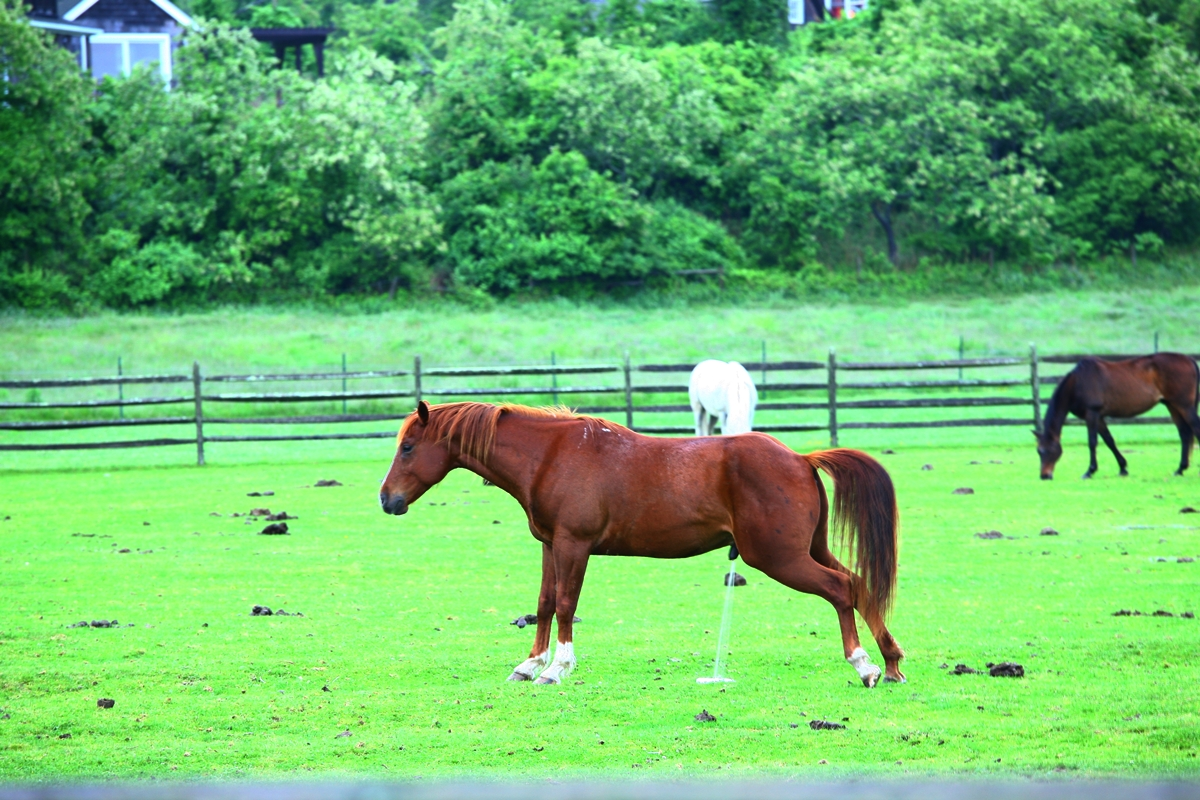
Choroby układu moczowego:
Zapalenie nerek
Zapaleniu nerek towarzyszy podwyższona temperatura, gorączka, obecność krwi w moczu, a także ból w okolicy nerek. Może być spowodowana infekcją pęcherza moczowego lub pojawić się w następstwie posocznicy źrebiąt.
Zapalenie pęcherza moczowego
Objawia się częstym oddawaniem moczu i towarzyszącym temu bólem. Mocz może być gęsty, a nawet zawierać krew. Powodem zapalenia pęcherza może być infekcja pochwy, cewki moczowej, ale również może pojawić się po przebytej kamicy nerkowej.
Zapalenie puzdra
Spowodowane może być uszkodzeniem błony napletka i prąca. Towarzyszy mu obrzęk i wydzielina o przykrym zapachu oraz trudności w oddawaniu moczu.
Choroby układu rozrodczego:
Wnętrostwo
Polega na niezstąpieniu jednego lub obydwu jąder do moszny. Wymaga chirurgicznego usunięcia jądra lub jąder.
Choroba weneryczna
Wywołana jest infekcją bakteryjną, często jest niezauważona, aż do momentu zarażenia klaczy przez ogiera.
Otręt koni
Otręt wywołuje Herpeswirus szczepu EHV-3. Skutkuje licznymi, wypełnionymi płynem pęcherzykami umiejscowionymi na narządach płciowych konia.
Zapalenie jąder
Może być spowodowane infekcją lub urazem mechanicznym. Obserwuje się bolesny obrzęk jąder, spadek apetytu i podwyższoną temperaturę.
Załupek (paraliż prącia)
Pojawia się w konsekwencji stosowania leków uspokajających na bazie promazyny. Porażone prącie wymaga natychmiastowego odprowadzenia prącia do napletka, gdyż inaczej konieczne może być jego chirurgiczne usunięcie.
Endometrioza
Forma ostra może być spowodowana infekcją błony śluzowej macicy po urazie lub infekcją bakteryjną przekazaną w drodze krycia ogierem. Postać przewlekła może wynikać z zakażenia i infekcji pochwy. Objawiać się może nieszczelnością sromu lub spadkiem odporności miejscowej (wczesne ruje, wydzielina).
Zakaźne zapalenie macicy
Wywołane jest przez bakterie Taylorella equigenitalis. Towarzyszy mu wydzielanie się z pochwy obfitej, szarej i śluzowo-ropnej wydzieliny.
Nieszczelność sromu
U klaczy z nieszczelnością sromu słyszalne jest zasysanie powietrza pochwą, a także obecna jest infekcja pochwy. Jej występowanie może wynikać z budowy pochwy klaczy lub być spowodowane urazem podczas porodu.
Przetoka odbytniczo-pochowa
Do przetoki może dojść na skutek rozerwania przy komplikacjach okołoporodowych. Objawia się wydalaniem kału odbytem oraz pochwą.
Skręt macicy
Skręt macicy może być spowodowany gwałtownymi ruchami klaczy w ciąży lub płodu. Klacz może dawać objawy kolki.
Torbiele macicy
Najprawdopodobniej powstają na skutek procesu starzenia się klaczy. Torbiele, inaczej cysty, rosną w kierunku światła macicy i najczęściej spotyka się je u klaczy powyżej 10 r.ż.
Wypadnięcie pochwy, macicy
Do wypadnięcia może dojść w wyniku niedobranego krycia lub porodu zbyt dużego źrebaka. Wypadnięcie pochwy sygnalizuje zaróżowiony obrzęk tych okolic o wielkości grejpfruta. Wypadnięcie macicy objawia się obrzękiem w sromie, który jest dobrze widoczny i wiotki w dotyku.
Komplikacje podczas porodu:
Tężyczka laktacyjna
Przyczyną jest zaburzenie metaboliczne u klaczy karmiących, a dokładniej obniżenie poziomu wapnia we krwi. Dochodzi do sztywności konia, zaburzeń ruchu, drgawek, pozycji prężących, a ostatecznie pozycji leżącej. Leczenie polega na dożylnym podawaniu wapnia.
Zapalenie gruczołu mlekowego
Spowodowane jest infekcją bakteryjną i objawia się wysoką ciepłotą gruczołów mlekowych, które stają się twarde i opuchnięte. Dodatkowo obserwuje się podwyższoną temperaturę konia, apatię, sztywność, brak apetytu i wydzielanie się gęstej wydzieliny o zmienionym kolorze z gruczołu mlekowego.
Zatrzymanie łożyska
Przyczyny zatrzymania łożyska nie są znane. Widoczna jest zwisająca ze sromu pępowina, zazwyczaj po ponad 4 godzinach od porodu. Zaleca się ręczne usunięcie łożyska lub podanie roztworu soli i oksytocyny.
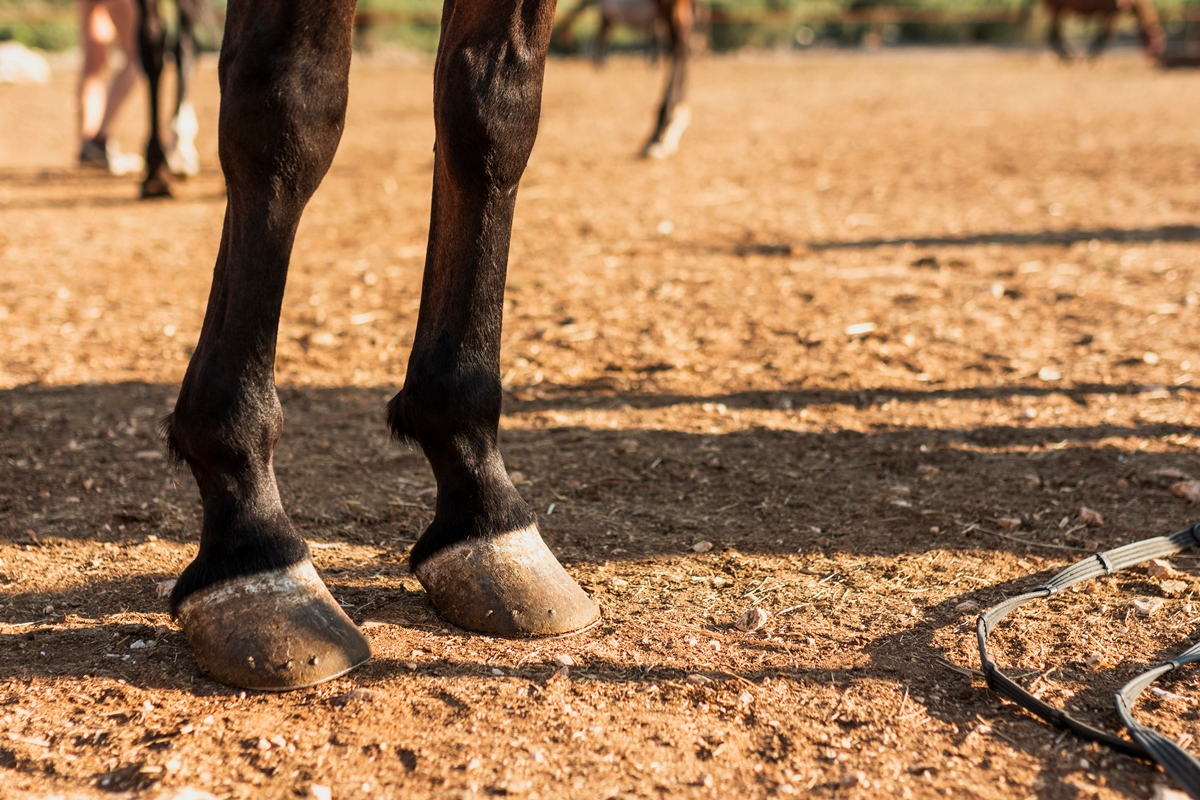
Choroby kopyt:
Choroba linii białej
Spowodowana jest infekcją kopyta szczepami grzybów, czemu sprzyja wilgotne i błotniste podłoże. Dochodzi do oddzielenia się ściany kopyta od dolnej do górnej krawędzi w okolicy linii białej. Powstaje wgłębienie w którym gromadzi się wydzielina o nieprzyjemnym zapachu.
Gnicie strzałki może wynikać z słabej odporności konia oraz przebywania na mokrym i błotnistym podłożu. Widoczna jest obecna w grocie strzałki czarna wydzielina o przykrym zapachu. Strzałka jest miękka i może posiadać rozwarstwione fragmenty, tzw. "kieszonki" w których zbierają się zanieczyszczenia w obrębie kopyt.
Jest to tak zwana dermatofiloza, która najczęściej dotyka konie przebywające na wilgotnym, błotnistym i niehigienicznym podłożu. Leczenie grudy polega na zadbaniu o czystość i suchość nóg konia, niekiedy konieczne jest podanie antybiotyku.
Kostnienie chrząstek kopytowych
Dochodzi do niego na skutek wstrząsów wpływających na tylny obszar kości kopytowej. Widoczna jest kulawizna, zwiększa się temperatura ciała konia i obrzęk, a także skostnienie potwierdza badanie RTG.
Martwica chrząstek kopytowych
U konia z martwicą chrząstek kopytowych obserwuje się bolesne, obrzęknięte piętki o podwyższonej ciepłocie w dotyku. Może wydzielać się ropna wydzielina z koronki kopyta. Taki stan spowodowany jest zakażeniem i martwica chrząstek kopytowej w wyniku urazu mechanicznego.
Nagniotki
Do uszkodzenia piętek dochodzi zazwyczaj w wyniku złego dopasowania podków. Koń wykazuje oznaki kulawizny o różnych stopniu nasilenia lub obciąża boczne ściany kopyt podczas poruszania się.
Obrączka (kostniejące okołostawowe zapalenie stawu kopytowego lub koronowego)
Przyczyną powstania obrączki jest uraz kości pęcinowej lub naciągnięcie więzadeł wiążących stawy. Widoczna jest lekka kulawizna i twarda deformacja nad koronką kopyta.
O pojawieniu się ochwatu może świadczyć silny ból kopyt, obrzęk i przebieranie charakterystycznej postawy ciała. Dotykiem można wyczuć gorące kopyta. Mogą go spowodować zbyt duże ilości cukrów w diecie konia, które prowadzą do produkowania endotoksyn, podwyższenia ciśnienia krwi i ograniczenia dopływu krwi do kończyn. Następnie dochodzi do degeneracji i oddzielenia tkanki listewkowej (kopyto ochwatowe). Wywołuje on zapalenie tworzywa kopytowego w wyniku czego może dość do deformacji kopyt. Leczenie ochwatu zależy od indywidualnego przypadku, jednakże jedną z form leczenia jest na przykład założenie plastrów nitroglicerynowych na tętnicach palcowych za stawem pęcinowym.
Podbicie
Powstaje na skutek urazu mechanicznego i powoduje kulawiznę oraz zmianę koloru kopyta w miejscu uderzenia.
Ropień kopyta
Może wynikać z podbicia, nagniotków lub infekcji rany drążącej w kopycie. Widoczna jest ostra kulawizna, gorące w dotyku kopyto z wyczuwalnym pulsem, a ostatecznie wypływ ropy w okolicy koronki.
Rozwarstwienie kopyta
Obserwuje się ubytek krawędzi kopyta wypełniony łuszczącą substancją. Powstaje na skutek przewlekłej postaci ochwatu lub urazu podeszwy kopyta.
Syndrom trzeszczkowy
Podejrzewa się, że za syndrom trzeszczkowy może odpowiadać uraz mechaniczny, nieprawidłowy dopływ krwi do trzeszczek lub zwyrodnienia trzeszczek. Kopyto konia z długotrwałym syndromem przypomina sześcian, a jego piętki wydają się ściśnięte. Widoczna jest kulawizna lub obciążanie bocznych ścian kopyt podczas poruszania się.
Zagwożdżenie
Spowodowane jest nieprawidłowym wbiciem podkowiaka podczas podkuwania konia. Koń wykazuje objawy bólowe podczas wbijania podkowiaka, może występować krwawienie miejsca uszkodzenia, a następnie pojawia się kulawizna.
Choroby kości, stawów, ścięgien i więzadeł:
Choroba zwyrodnieniowa stawów (osteoartroza)
Są to zmiany struktur chrzęstnych związane z procesem starzenia się konia, nadmiernym wysiłkiem lub przekarmianiem w okresie źrebięcym. Koniom borykającym się ze zwyrodnieniami towarzyszy ból danego stawu, kulawizna oraz czasami obrzęk i zwiększona ciepłota chorego obszaru.
Naciągnięcie ścięgna
Naciągnięcie ścięgna oznacza przekroczenie potencjału elastyczności ścięgna, które skutkuje kulawizną, ciepłotą miejsca urazu, obrzękiem oraz bólem.
Nakostniaki
Powodem powstania nakostniaków może być uraz lub zbyt szybki powrót do intensywnej pracy starszych koni. Niekiedy obserwuje się uszkodzenie niedojrzałej kości, który skutkuje urazem więzadła łączącego nadpięcie z kością rysikową. Nakostniaki to twarde w dotyku, kostne deformacje zazwyczaj umieszczone na wewnętrznej stronie kości nadpięcia. Często pomocna w leczeniu jest boswelia dla koni.
Opoje
Są to miękkie w dotyku deformacje umiejscowione w okolicy stawu pęcinowego. Opoje u konia mogą być spowodowane naciągnięciem stawu pęcinowego. Niekiedy zaleca się terapię polegającą na wstrzykiwaniu kortyzolu w celu zmniejszenia większych rozmiarów opojów.
Pipak (zapalenie kaletki maziowej guza łokciowego)
Jest to miękka deformacja umiejscowiona nad guzem piętowym. Najprawdopodobniej powoduje ją wada postawy konia.
Istnieją dwa rodzaju szpatu: krwisty oraz kostny. Pierwszy z nich objawia się występowaniem miękkich obrzęków w okolicy stawu skokowego. Szpat kostny charakteryzuje się trudną do zdiagnozowania kulawizną kończyn tylnych, ograniczeniami w zginaniu oraz skróconym wykrokiem.
Zadzierzgnięcie rzepki (wypadnięcie rzepki konia)
Wypadnięciu rzepki towarzyszy wyraźnie słyszalny odgłos trzasku i zablokowanie tylnej kończyny. Powodem jest nieprawidłowy układ ustaleniowy tylnych kończyn, który uniemożliwia prawidłowe uwolnienie rzepki z nadkłykcia przyśrodkowego kości udowej podczas ruchu.
Zajęczak (zapalenie więzadła podeszwowego)
Charakteryzuje się kulawizną i powiększeniem więzadła podeszwowego tylnej strony stawu skokowego. Może wynikać z wady budowy konia lub nadwyrężenia.
Zatrat, strychowanie
Spowodowany jest wadą budowy konia lub jego zmęczeniem. Polega na uderzaniu kopytem lub podkową kończyny o część wewnętrzną koronki, nadpięcia, bądź pęciny nogi przeciwległej.
Zatrat, ściganie
Jest to uraz okolicy piętek nogi przedniej powstały w wyniku uderzania kopytem kończyny tylnej, najczęściej leżącej po tej samej stronie. Spowodowany jest nieprawidłową budową lub podkuwaniem.
Zesztywnienie stawów
Zesztywnienie może być wrodzone lub powstać na skutek urazu mechanicznego, innych chorób lub po operacji planowej. Objawia się nieprawidłową ruchomością stawów.
Choroby układu mięśniowego:
Drżenie
Przyczyny drżenia nie są znane. Obserwuje się drżenie i nadmiernie zgiętą tylną nogę. Koń może mieć problem z utrzymaniem pozycji stojącej.
Koń cierpiący na mięśniochwat przejawia oznaki niepokoju, intensywne pocenie się, sztywność i niechęć do ruchu, a jego mięśnie są obrzęknięte i obolałe. Mocz może być o zmienionym kolorze. Przyczyny powstania nie są do końca znane, ale niektóre badania wykazują pewien związek drżenia z gromadzeniem się wapnia w komórkach mięśniowych.
Choroby kręgosłupa:
Przetoki kłębu (norzyca kłębu)
Do norzycy kłębu może dojść na skutek urazu lub zakażenia bakteryjnego (Brucella abortus). Kłąb konia jest opuchnięty, bolesny i wyczuwalna jest zwiększona jego ciepłota. Widoczne są przetoki w których powstają ropiejące rany.
Kissing Spine Syndrome (KSS)
Polega na stykaniu się wyrostków kolczystych przez zbyt małą dzielącą je odległość. Może być spowodowane nieprawidłową budową ciała, powtarzającym się urazem mechanicznym, stanem zapalnym, utratą mięśni grzbietu lub zwyrodnieniami.

Choroby skóry:
Brodawczyca
Za pojawienie się brodawczycy odpowiada wirus brodawczaka koni. Objawia się ona wysypem guzków niewielkich rozmiarów w okolicy oczu, chrap i ogona.
Czerniak
Powszechne schorzenie koni maści siwej. Obserwuje się powstanie nowotworu komórek skóry odpowiadających za produkcję melatoniny. Widoczne są różnego rozmiaru, twarde guzki o czarnym kolorze, cysty w okolicy odbytu, oczu lub węzłów chłonnych. Rzadko zaleca się zabieg chirurgiczny ze względu na ryzyko przerzutów.
Czyrak, czyraczność
Powodem pojawiania się czyraka lub czyraczności jest zapalenie mieszków włosowych, często spowodowane strzyżeniem sierści. W okolicy zapalenia powstają grudki i zmiany wrzodowe. W przypadku czyraka obserwuje się pojedynczy bolesny guz z tendencją do rośnięcia i wydzielający surowiczą substancję.
Grzybica woszczynowa
Widoczne są twarde, okrągłe zmiany w postaci strupów z tendencją do rozprzestrzeniania się. Za zarażenie odpowiada grzyb z rodziny Histoplasma farciminosum.
Łojotok
Łojotok może być spowodowany przebytą infekcją skóry np. wszawicą lub nużycą. Sierść łojotokowa jest tłusta i widoczny jest łupież.
Nekrobioza grudkowata
Najczęściej powstaje w wyniku reakcji alergicznej na ugryzienia owadów. Pojawiają się niebolesne guzki w okolicy szyi lub grzbietu, które mogą mieć różną wielkość.
Sarkoidy
Są to miejscowe nowotwory skóry. Wyróżnia się sześć rodzajów sarkoidów: ukryte, brodawkowate, włókniste, złośliwe, grudkowate i mieszane. Sarkoidy u koni mają charakter wirusowy i pojawić się w dowolnej części ciała konia.
Przyczyną rain scald jest początkowe zakażenie bakteryjne (Dermatophilus congolensis). Pojawiają się zmiany strupowate na grzbiecie i szyi konia. Obserwuje się również duży dyskomfort zwierzęcia i obniżenie jego kondycji.
Do poparzenia dochodzi najczęściej w miejscach wrażliwej skóry pyska.
Ropień
Jest on najczęściej następstwem drążącej rany lub infekcji. Obrzęk najpierw jest twardy i gorący, jednak z czasem staje się miękki, aż do pęknięcia skóry i wypłynięcia płynu ropnego.
Torbiel naskórkowa lub zębonośna
Jest to wada wrodzona u koni przejawiająca się obrzękiem skórnym ucha lub nozdrzy. Zaleca się usunięcie torbieli poprzez zabieg chirurgiczny.
Zapalenie mieszków włosowych
Do zapalenia może dojść przez nieodpowiednią higienę skóry konia lub infekcję bakteryjną. Pojawiają się bolesne, małe guzki na skórze, które pękają przez co widoczne są pozbawione sierści obszary w trakcie gojenia.
Zapoprężenie
Widoczny jest guzek na skórze, wypadająca sierść lub żywe mięso w miejscu podpięcia popręgu. Zapoprężenie może powstać na skutek zanieczyszczonego popręgu lub zbyt mocnego podpinania popręgu.
O podłożu alergicznym:
Lipcówka
Lipcówka u koni powstaje w reakcji na ugryzienia muchówek z rodziny Culicoides. Pojawia się miejscowe zapalenie skóry w okolicy grzywy, ogona i potylicy. Skóra konia jest widocznie zgrubiała i obrzęknięta. Koń odczuwa silny świąd, ociera się i może spowodować tym wypadanie sierści.
Łysienie plackowate
Przyczyną łysienia plackowatego są antygeny w mieszkach włosowych wywołujące reakcję autoimmunologiczną. Najczęściej wyłysienie obserwuje się w okolicy pyska.
Pokrzywka
Jest to powszechna reakcja organizmu konia na nagłą zmianę żywienia. Widoczne są bąble pokrywające skórę konia. Zaleca się terapię z użyciem leków antyhistaminowych.
O podłożu pasożytniczym:
Filariozy koni
Powoduje ją larwa pasożyta Setaria equina. Koń przejawia oznaki złego samopoczucia, pojawia się gorączka, obrzęk i zapalenie spojówek.
Leiszmanioza
Wywołana jest zakażeniem pasożytem pierwotniakowym z rodziny Leiszmania. Pojawiają się wrzody i zmiany łysiejące w okolicy pyska.
Ślepota rzeczna
Objawia się plackami łuskowatymi środkowej linii ciała, kłębu i klatki piersiowej. Może dojść do uszkodzenia gałki ocznej i odpigmentowania fragmentów skóry. Powstaje w wyniku zakażenia skóry przez mikrofilarię pasożyta Onchocerca cervicalis.
Choroby przemiany materii:
Hiperlipidemia
Jest to zaburzenie metabolizmu tłuszczów, które może być spowodowane przez stres u koni szczególnie otłuszczonych lub kucyków. Pojawia się spowolnienie ruchu, apatia, brak apetytu, problemy neurologiczne, duża utrata masy ciała i ospałość.
Mioglobinuria
Często obserwuje się jej pojawienie u więcej niż jednego konia w stadzie. W pozycji leżącej pojawia się problem ze zmianą pozycji bocznej na mostkową. Podczas stania koń może okazywać ospałość i niechęć do ruchu, a jego mocz może przybrać barwę brązową. W badaniach krwi najczęściej widoczne jest poważne uszkodzenie mięśni.
Odwodnienie
Do odwodnienia często dochodzi na skutek przebytych chorób lub przez nadmierną potliwość po wysiłku. Można je rozpoznać po suchej, zapadniętej i napiętej skórze oraz ogólnym otępieniu zwierzęcia.
Udar słoneczny
Powstaje na skutek braku odpowiednio szybkiego wydalanie ciepła z organizmu konia, często na skutek przeciążenia wysiłkowego. Obserwowalne są przyspieszony oddech, tętno, gorączka, apatia, zaczerwienienie śluzówki, kurczenie mięśni i niechęć do ruchu. Przy braku leczenia może dojść do zapaści i śmierci.
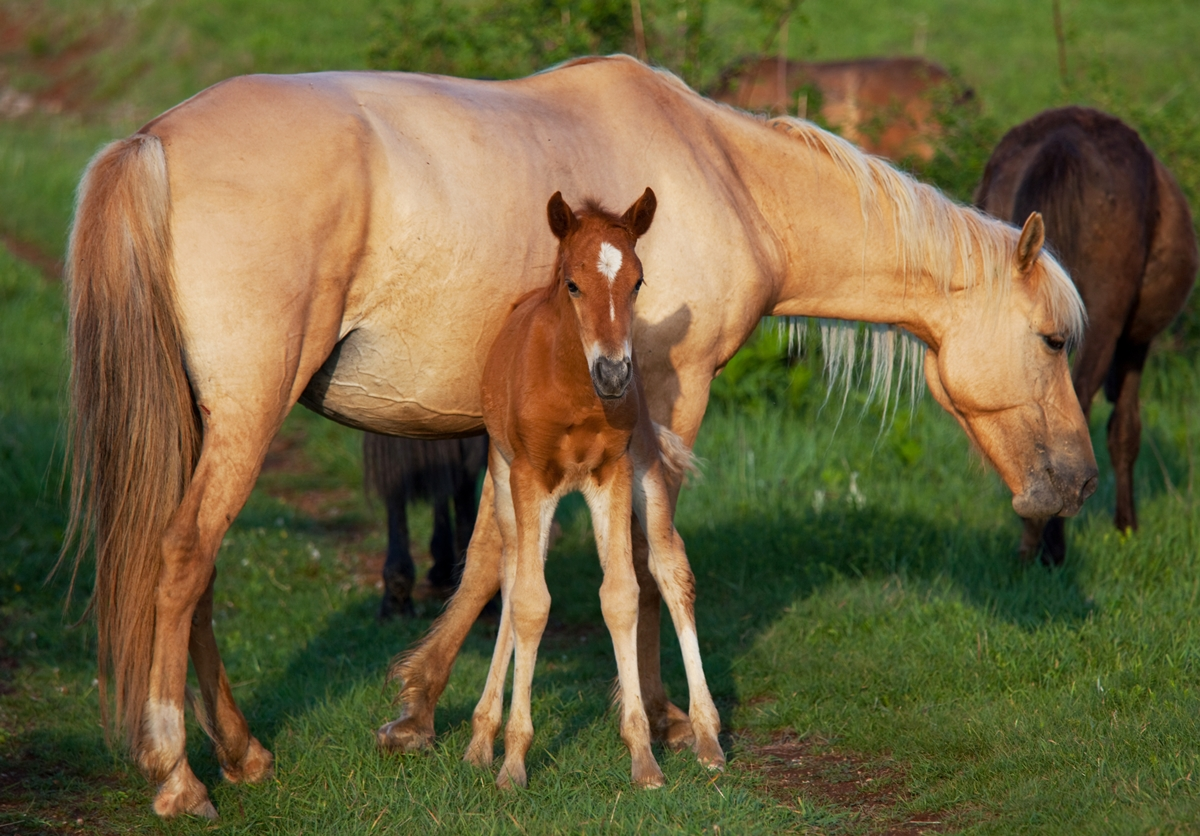
Choroby źrebiąt:
Bakteryjne zapalenie stawów (kulawka źrebiąt)
Do kulawki u źrebiąt może dojść na skutek zakażenia pępowiny, posocznicy lub bakteryjnego zakażenia stawów. Stawy źrebięcia są obrzęknięte i gorące, przez co widoczna jest kulawizna. Źrebię jest wygląda na osłabione i chore, przestaje pić mleko. Choroba prowadzi do nieodwracalnych zmian w stawach.
Choroba hemolityczna
Do choroby hemolitycznej dochodzi, gdy krwinki czerwone źrebięcia są inne od krwinek matki. Przeciwciała atakujące krwinki czerwone źrebięcia są przenoszone do jego organizmu podczas spożywania siary.
Choroba spichrzeniowa glikogenu typu IV (GBED)
Polega na niedoborze enzymu GBE, który skutkuje nagromadzeniem się nieprawidłowych cząstek glikogenu w obszarze mięśni szkieletowych i mięśnia sercowego.
Deformacja stawu pęcinowego przejawia się całkowitym wyprostowaniem stawów pęcinowych. W niektórych przypadkach konieczne jest założenie wkładek wydłużających.
Objawiają się skurczem ścięgien stawu pęcinowego oraz nadgarstkowego. Zazwyczaj ustępuje samoistnie, lecz czasami wymaga założenia specjalnych szyn.
Niedoczynność tarczycy
U źrebiąt powoduję ją niedobór lub nadmiar jodu u matki podczas ciąży. Źrebię ma powiększoną tarczycę, jest apatyczne i osłabione.
Niezarośnięty moczownik
Do niezamknięcia moczownika dochodzi podczas porodu. Źrebię ma problem z oddawaniem moczu, przyjmuje pozycje ulgowe, z kikuta pępowiny wydobywa się mocz oraz może dojść do zakażenia.
Posocznica źrebiąt
Źrebię chorujące na posocznice jest apatyczne, ma gorączkę i brak apetytu. Może zapaść w śpiączkę po której następuje śmierć. Do zachorowania dochodzi przez zakażone łożysko.
Przepuklina
Wyróżnia się przepuklinę pępkową i pachwinową. Pierwsza z nich spowodowana jest nieprawidłowościami ściany brzusznej i charakteryzuje się opuchlizną okolic pępka. Przepuklina pachwinowa wynika z wypuklenia jelit przez pierścień pachwinowy i objawia się deformacją obszaru pachwiny.
Przykurcz ścięgien
U źrebiąt przykurcz ścięgien może być spowodowany różnicą w rozwoju ścięgien mięśni zginaczy, a kości dolnych partii kończyn. Obserwuje się charakterystyczne opieranie czubka kopyta podczas pozycji stojącej lub pionowe ustawienie pęcin.
Syndrom źrebięcia lawendowego
Jest to śmiertelna choroba genetyczna, która przejawia się jasnych lub nietypowych kolorem źrebięcia po urodzeniu. Dochodzi do ciężkich objawów neurologicznych, a następnie śmierci zwierzęcia.
Skrzywienie nosa
Do skrzywienia nosa może dojść w wyniku nieprawidłowej pozycji płodu w macicy, która powoduje nacisk na kość nosową.
Wcześniactwo
Oznacza niedonoszenie ciąży do planowanego terminu rozwiązania. Źrebię urodzone zbyt wcześnie najczęściej cechuje się niską wagą ciała, ma trudności ze ssaniem i utrzymaniem prawidłowej temperatury ciała.
Zapalenie pępowiny
Zakażenia sznura pępowinowego objawia się jego wysoką temperaturą i opuchlizną. Źrebię jest apatyczne, osłabione i nie ma apetytu. Niekiedy może dojść do gromadzenia się ropy w pępowinie i zapalenia stawów.
Zesztywnienie stawów źrebiąt
Wrodzone zesztywnienie stawów najczęściej wymaga podjęcia decyzji o eutanazji.
Zniekształcenia kończyn u źrebiąt (deformacje kątowe)
Przyczyną deformacji kątowych u źrebiąt jest nieprawidłowe lub niepełne skostnienie kości, luźne więzadła lub torebki stawowe. Polega na patologicznym odchyleniu kończyn w stosunku do prawidłowej osi.
Zatrzymanie smółki
Charakteryzuje się zachowaniami takimi jak: drżenie ogona, kładzenie się, przyjmowanie pozycji ulgowych, napinanie się, wyraźny dyskomfort.
Zespół nieprzystosowania noworodkowego
Może on przejawiać się różnymi zachowaniami takimi jak: drgawki, utraty przytomności, brak ssania, drżenie kończyn, wpatrywaniem się w jeden punkt czy ogólnym otępieniem. Powstaje na skutek uszkodzenia mózgu podczas porodu.
Choroby sysaków:
Choroba Tyzzera
Wywołuje ją bakteria Bacillus piliformis prowadząca do ostrego zapalenia wątroby. Źrebię jest depresyjne i ma gorączkę. Następnie dochodzi do zapaści i śmierci konia.
Złożone niedobory odporności
Jest to choroba genetyczna - gen regresywny upośledza rozwijający się układ odpornościowy. Kilka tygodni po porodzie źrebię zaczyna zapadać na różne, oporne na leczenie choroby układu oddechowego, Dotyczy źrebiąt rasy arabskiej.
Choroby roczniaków:
Zespół Wobblera (zespół chwiejności)
Dotyczy ogierów rasy pełnej krwi angielskiej od 1-2 roku życia. Następuje postępująca utrata kontroli kończyn tylnych, przez co dochodzi do braku możliwości stania u konia.
Choroby starszych koni:
Miopatia spowodowana gromadzeniem polisacharydów
Występuje u osobników o mocnym umięśnieniu. Podczas ataku choroby koń przyjmuje skuloną pozycję, drży i nadmiernie się poci. Mięśnie są spięte i bolesne.
Zespół Cushinga
Najczęściej pojawia się u koni starszych i kucy w wyniku wzmożonej produkcji hormonów przysadki mózgowej. Charakteryzuje się utratą wagi, obniżoną odpornością, częstym picie i oddawaniem moczu. Sierść jest zmierzwiona, długa i zakręcona.
Choroby układu nerwowego:
Choroba neurona ruchowego koni (EMND)
Jest ona spowodowana zbyt dużą ilością przeciwutleniaczy w diecie konia (dieta bogata w zboża i uboga w pasze objętościowe). Obserwuje się osłabienie, a następnie zanik mięśni górnej linii ciała zwierzęcia.
Zespół ogona końskiego (CEN)
Przyczyną CEN jest zapalenie korzeni nerwów lędźwiowych, krzyżowych, a nawet czaszkowych. Dochodzi do utraty czucia lub paraliżu okolic ogona, nietrzymania moczu, osłabienia kończyn tylnych i ataksji. W przypadku zapalenia nerwów czaszkowych może wystąpić paraliż pyska.
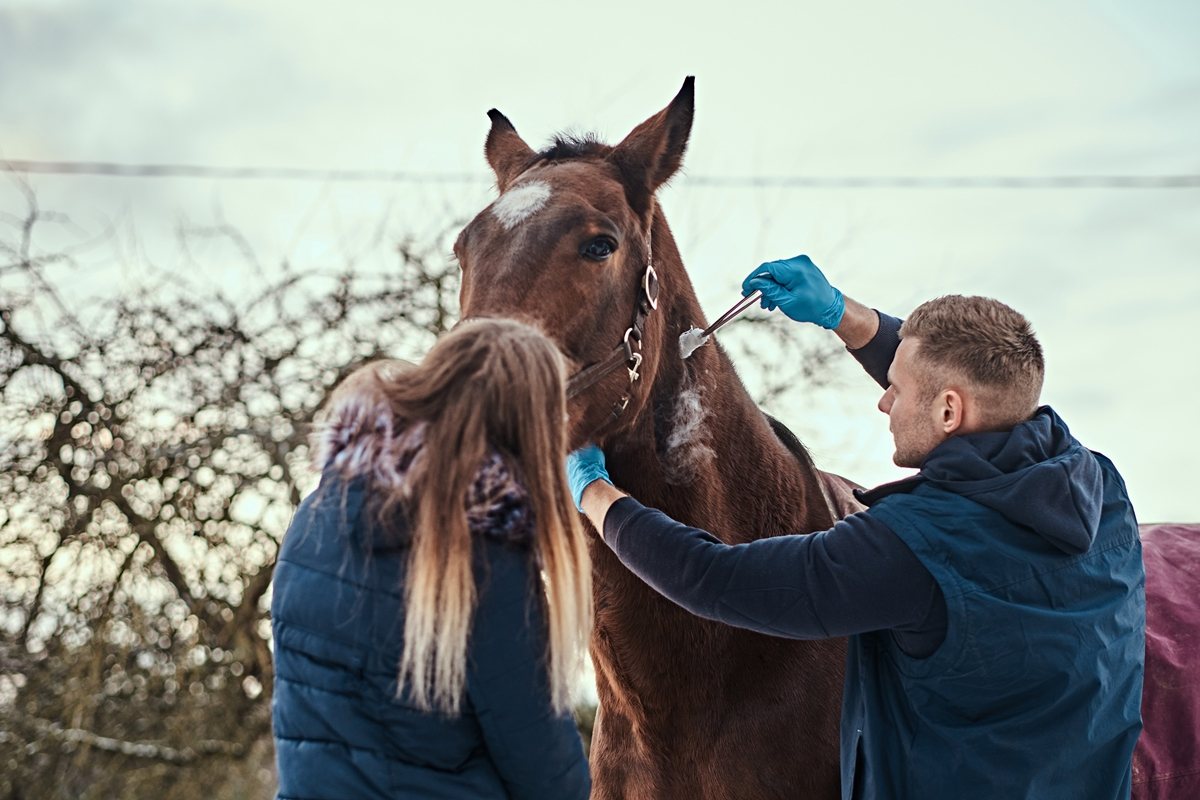
Zakażenia ogólne
Influenza końska (grypa końska)
Grypa u koni to poważne schorzenie układu oddechowego. Końska grypa wynika z zarażenia wirusem typu A. Objawia się podwyższoną temperaturą, wydzieliną z nosa o przeźroczystej barwie oraz kaszlem.
Tężec
Przyczyną zachorowania na tężec u konia jest zarażenie rany laseczką tężca Clostridium tetani. Produkuje ona toksyny, które przenoszone są do mózgu zwierzęcia. Charakterystyczne objawy to: postępujący paraliż prowadzący do śmierci, wypadanie trzeciej powieki, uniesienie nasady ogona i postawione uszu konia.
Wąglik
Do zachorowania dochodzi na skutek spożycia skażonego laseczką wąglika (Bacillus anthracis) pokarmu. Infekcja jest ostra i szybko postępuje prowadząc do śmierci zwierzęcia. Obserwuje się podwyższoną temperaturę, apatię, ostrą kolkę, niewydolność oddechową, powiększoną śledzionę i krwistą wydzielinę z nosa.
Rinowirus
Rinowirus często dotyka młode konie o obniżonej odporności. Następuje nagły i krótki skok temperatury, kaszel oraz z nosa wydobywa się wydzielina.
Rotawirus
Zarażenie wirusem odbywa się poprzez spożycie skażonego pokarmu lub lizanie skażonych powierzchni. Dotyczy źrebiąt do 6 miesiąca życia powodując słaby odruch ssania, apatię, odwodnienie i biegunkę.
Wścieklizna
Jest to choroba wirusowa rozprzestrzeniająca się poprzez ugryzienie przez zarażonego osobnika. Dochodzi do postępującego paraliżu, któremu towarzyszy podwyższona temperatura i apatia. Śmierć następuje od 4 do 5 dni od zarażenia.
Borelioza (choroba z Lyme)
Do zachorowania na boreliozę u koni dochodzi przez bakterię Borrelia burgdorferi, która przenoszona jest przez kleszcze. Może wywołać gorączkę, kulawiznę, zapalenie stawów, niechęć do ruchu oraz apatię.
Posocznica
Wywołują ją bakterię, które przedostają się do organizmu przez uszkodzoną błonę jelita konia. Objawia się kolką, biegunką, odwodnieniem, wyraźną apatią i przyspieszonym tętnem. Posocznica u koni może prowadzić do wtórnego ochwatu. Najczęściej kończy się wstrząsem, śpiączką i śmiercią zwierzęcia.
Nosacizna
Nosacizna u koni wywołana jest przez bakterie Pseudomonas mallei. Jest ona również bardzo niebezpieczna dla człowieka, dlatego często nie zaleca się leczenia zwierzęcia ze względu na ryzyko zachorowania opiekuna. Powoduje ostre zapalenie płuc, kaszel, wysoką temperaturę i spadek masy ciała.
Piroplazmoza (babeszjoza, kleszczowe zapalenie mózgu koni)
Jest ona przenoszona przez kleszcze i daje objawy takie jak: osłabienie, zżółcenie śluzówki, apatia, gorączka, krew w moczu oraz obrzęk zainfekowanych obszarów.
Wirusowe zapalenie tętnic
Wirus przenoszony jest przez bezpośredni kontakt z zarażonym osobnikiem. Pojawia się gorączka, depresja, opuchlizna kończyn, brak apetytu, obrzęk brzucha i okolic oczu, zapalenie spojówek i wyciek z nosa.
Adenowirus
Patogen powoduje infekcję górnych dróg oddechowych, dając objawy takie jak: biegunka, podwyższona temperatura i wyciek z nosa konia.
Za zachorowanie odpowiada rodzina wirusów dzieląca się na osiem szczepów, z czego najpowszechniejsze to EHV-1, EHV-4 oraz EHV-3. Obserwuje się u koni zarażonych podwyższoną temperaturę, obfitą wydzielinę z nosa, niekiedy objawy neurologiczne, a w przypadku klaczy może dojść do poronienia.
Zatrucie jadem kiełbasianym
Do zatrucia jadem kiełbasianym u koni dochodzi w wyniku spożycia zepsutej paszy zawierającej toksyny pałeczki jadu kiełbasianego (Clostridium botulinum). Chory koń jest osłabiony, ma problemy z nabieraniem i przeżuwaniem pokarmu. Może powłóczyć nogami, co ostatecznie prowadzi do zapaści i śmierci konia.
Zgorzel gazowa
Do zachorowania na zgorzel gazową dochodzi przez skażenie bakteriami rany, bądź wprowadzenie ich podczas wkłucia igłą. Widoczny jest duży obrzęk miejsca zakażenia. Obszar jest gorący, bolesny, a pod skórą gromadzą się gazy. Z rany wydziela się wydzielina o pienistej formie. Koń jest osowiały i apatyczny. Choroba najczęściej prowadzi do śmierci.
Zołzy
Zachorowanie wynika z zarażenia bakterią Streptococcus equi. Zwierzę ma podwyższoną temperaturę, kaszel, a z nosa wydziela się gęsta wydzielina. Obserwuje się trudności z przełykaniem przez powiększone węzły chłonne. Dochodzi do pęknięcia, które zaczyna ropieć.
Zaburzenia stereotypiczne koni - narowy:
Tkanie u koni najczęściej spowodowane jest brakiem zapewnienia mu podstawowych potrzeb, takich jak ruch i towarzystwo innych koni. Przez nudę oraz frustrację koń zaczyna wykonywać wahadłowy ruch głowy i szyi podczas przestępowania z nogi na nogę.
Łykanie powoduje skurcz mięśni szyi, czego następstwem jest obniżenie w dół krtani i wpadanie powietrza do gardła konia z charakterystycznym dźwiękiem. Koń może łykać opierając się zębami o twarde elementy.
Grzebanie nogą
Koń stereotypowo grzebie kopytem w podłożu. Jest to bardzo uciążliwy nawyk, który jest ciężki do oduczenia.
Obgryzanie
Polega na nawykowym obgryzaniu drewnianych lub plastikowych elementów otoczenia. Może prowadzić do zranień pyska konia.
4.Jak wykonać zastrzyk u konia?
Zastrzyk dożylny
Jeśli pozwalają nam na to umiejętności, możemy podać lek dożylnie. Zastrzyki dożylne wykonujemy tylko w wypadku leków, będących roztworami wodnymi lub płynami izoosmotycznymi (zawiesiny i roztwory olejowe nie wchodzą w grę!), a więc w tym wypadku jak najbardziej jest to wskazane. Lek aplikowany dożylnie zadziała najszybciej.
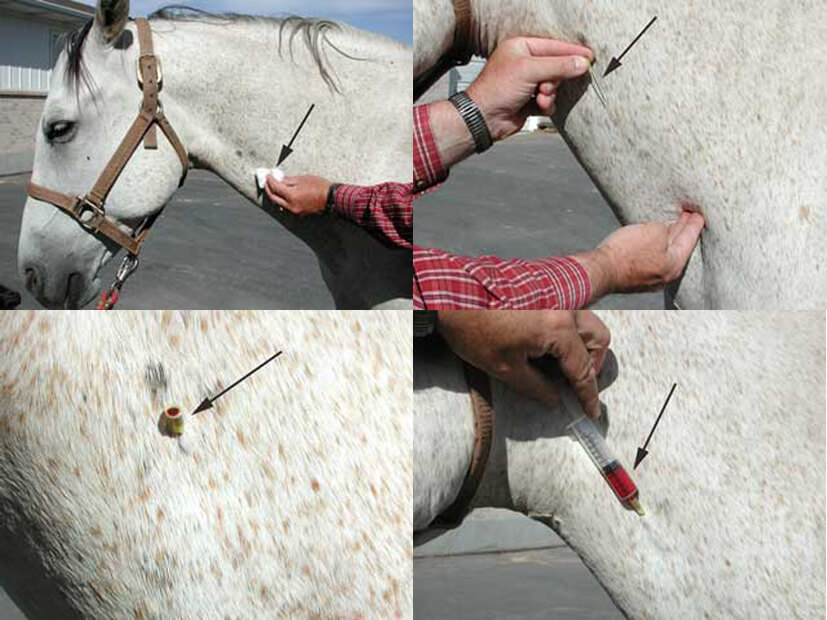
Warto najpierw odkazić planowane miejsce wkłucia (najlepiej na szyi, jak na wyżej załączonych obrazkach) oraz jego okolice, używając gazy nasączonej alkoholem (spirytus) bądź płynem dezynfekującym. Następnie należy znaleźć żyłę, w którą musimy się wkłuć. Aby to zrobić do widocznego wgłębienia idącego wzdłuż szyi dociskamy dwa palce (wskazujący i środkowy) i czekamy aż żyła pokaże się powyżej miejsca ucisku. Po uwypukleniu żyły wsuwamy w nią igłę pod stosunkowo niewielkim kątem 20-30 stopni. To bardzo ważne, ponieważ przy większym kącie wkłucia, szczególnie wbijając igłę pionowo (pod kątem 90 stopni) możemy przebić żyłę na wylot i zaaplikować lek poza nią.
Po wkłuciu dołączamy strzykawkę i wykonujemy tzw. aspirowanie, czyli zaciągamy tłok na 1-2 cm.. Jeśli w strzykawce pojawi się krew, możemy być pewni, że prawidłowo się wkłuliśmy. W takim wypadku możemy wpuścić lek dożylnie wraz z krwią, która została zassana do strzykawki, powoli, jednostajnym ruchem dociskając tłok. Po opróżnieniu strzykawki dociskamy kciuk powyżej miejsca wkłucia i bez pośpiechu wyciągamy igłę. Na koniec możemy przycisnąć miejsce wkłucia jałowym gazikiem, by ograniczyć krwawienie.
Zastrzyk domięśniowy
Lekarstwo podane domięśniowo zadziała dużo wolniej, niż te zaaplikowane dożylnie, jednakże osobom mniej doświadczonym łatwiej będzie go wykonać. Zastrzyk domięśniowy wykonuje się poprzez nakłucie dużych i dobrze ukrwionych, ale słabo unerwionych mięśni. Z tego powodu doskonałym miejscem jest końska szyja (tzw. "trójkąt szyjny" - mięsień czworoboczny) bądź zad (mięśnie pośladkowe), jeśli koń nie kopie. Należy jednak zdawać sobie sprawę, że są to miejsca bogate w naczynia krwionośne oraz mocno unerwione. Tą metodą można podawać leki będące roztworami izoosmotycznymi, wodnymi, oleistymi oraz zawiesinami.
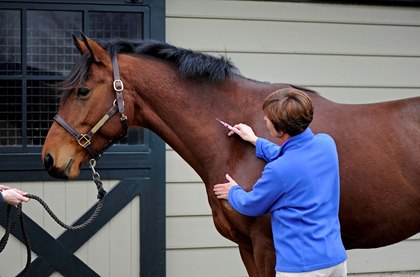
By wykonać zastrzyk domięśniowy w zad należy stanąć w "bezpiecznym miejscu" tj. równolegle do konia głową zwróconą w stronę ogona, przy jego guzie biodrowym, by być poza zasięgiem jego nóg. Z tego miejsca można bez problemu wykonać zastrzyk. Tak jak przy iniekcji dożylnej - miejsce wkłucia oraz jego okolice dezynfekujemy. Następnie, przechodzimy do wkłucia. Warto kilkukrotnie poklepać konia w zad, trzymając przygotowaną igłę ze strzykawką, by przy którymś klepnięciu szybko i zdecydowanie wbić ją prostopadle w mięsień.
Po wbiciu igły sprawdzamy, czy nie wkłuliśmy się w naczynia krwionośne poprzez wspomniane aspirowanie. Jeśli w strzykawce będzie krew, należy wyjąć igłę i powtórzyć zabieg. Jeśli krew się nie pojawi możemy wolnym, systematycznym ruchem wpuścić lek, a następnie powoli wyciągnąć strzykawkę. Po wszystkim możemy uciskać miejsce wkłucia za pomocą jałowego gazika.
Podobnie ma się sytuacja, jeśli chcemy wykonać zastrzyk w szyję. Warto jednak tuż przed wkłuciem złapać kawałek skóry tuż przed planowanym miejscem wkłucia, by odwrócić uwagę konia.
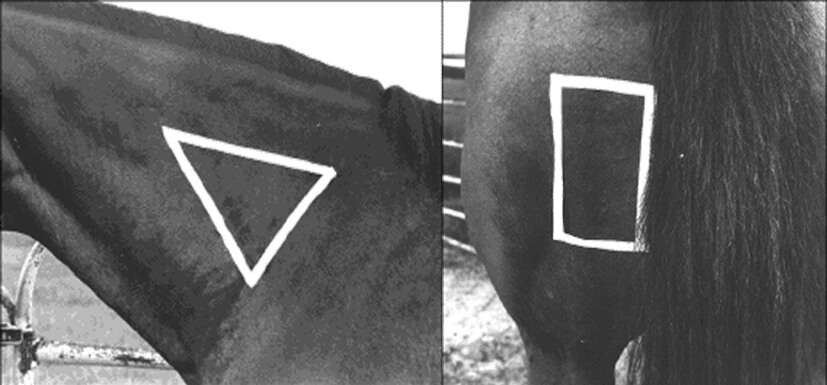
Lek rozkurczający zmniejszy ból oraz nie przekłamie wyników i obrazu choroby podczas badania weterynaryjnego. Ponadto, lekarz weterynarii nie będzie musiał tracić czasu na rozluźnianie konia, mogąc od razu leczyć konia poprzez poszukiwanie przyczyny problemu.
Ogromnym błędem w wypadku kolki jest podanie zwierzęciu środka przeciwbólowego przed przyjazdem weterynarza. Niestety może to uniemożliwić ocenienie realnego stanu zdrowia konia i zaawansowania dolegliwości, a w efekcie stwierdzenia czy jest potrzebna operacja. Zawsze należy najpierw telefonicznie zapytać lekarza czy możemy podać lek.
5.Rany u koni
Konie, jak powszechnie wiadomo mają silną potrzebę przebywania na zewnątrz, pasąc się oraz potrzebę kontaktu ze stadem. Niestety potrzeby te rodzą nasze obawy, ponieważ konie (nieważne jak dobrze zabezpieczymy teren i ogrodzenie) zawsze znajdą niezauważony przez nas element, który je zrani.
Oczywiste jest także to, że niekiedy konflikty powstające pomiędzy członkami grupy rozwiązuje się siłowo - kopytami oraz zębami. Wszystkie te "zagrożenia" sprawiają, że wielu właścicieli boi się w okresach startów wypuszczać konia na pastwisko.
Widok krwawiącego konia do przyjemnych nie należy, jednakże jeśli już przydarzy się nam taka sytuacja musimy wiedzieć jak zareagować, by nie tracąc głowy zabrać się do działania.
Jak opatrywać rany?
Po pierwsze: musimy dokładnie przyjrzeć się skaleczeniu i ocenić, czy dalszą opiekę przeprowadzimy sami - czy jest to tylko powierzchowne obtarcie mocno unaczynionego naskórka czy też powinniśmy wezwać weterynarza.
Niegroźne rany naskórka
Jeśli mamy do czynienia z takim przypadkiem rany (niewymagającym kontroli lekarza weterynarii) to należy początkowo zatamować krwawienie, jeśli ono występuje. Pamiętajmy, by nie pocierać rany opatrując ją oraz tamując krwawienie. Obecne w skaleczeniu ciała obce (np. ziarnka piasku) dodatkowo je podrażnią, zwiększając krwawienie, a tym samym sprawiając naszemu podopiecznemu ból.
Zamiast przecierać ranę należy odsączyć z wyczuciem krew, zalewającą zraniony obszar. Wykonujemy to poprzez przyłożenie jałowego opatrunku do miejsca skaleczenia i uciskanie go przez około 5 min. Do oczyszczenia rany warto użyć płynu fizjologicznego lub ostatecznie przegotowanej wody.
Następnie uszkodzone miejsce należy odkazić środkiem dezynfekującym np. Rivanolem. Po odkażeniu warto pozostawić ranę "samą sobie", nie stosując na nią żadnych maści, ponieważ wydłuża to proces gojenia. Ewentualnie możemy sięgnąć po różnego typu środki suche, przyspieszające proces powstawania strupa.
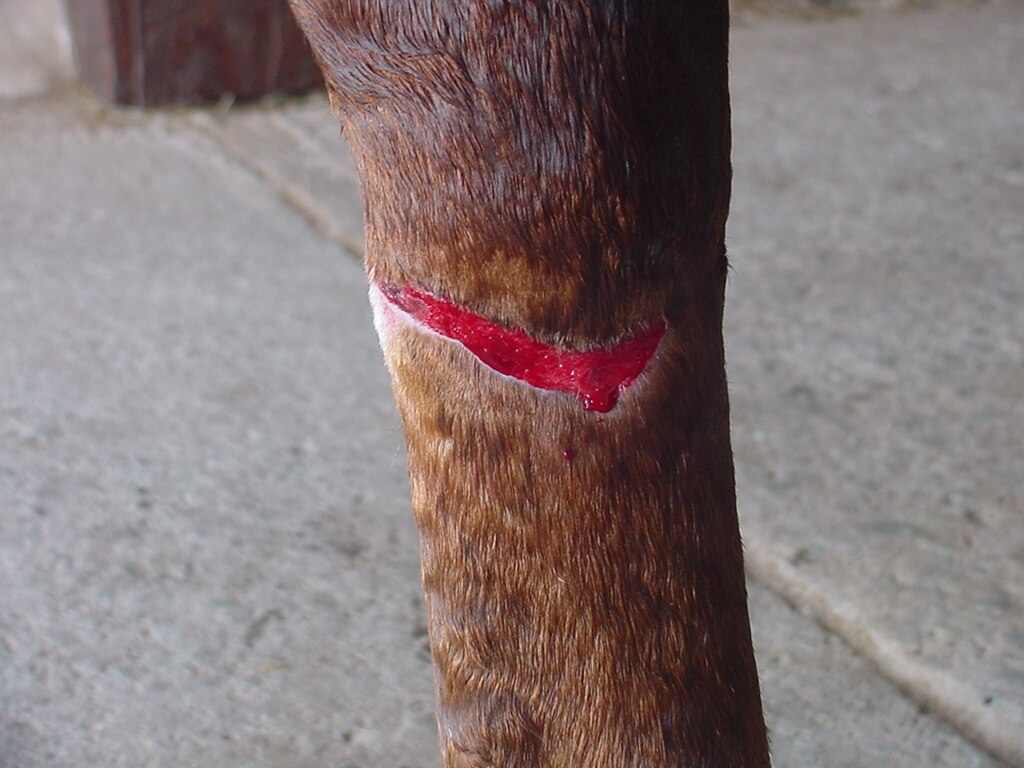
Poważne, głębokie rany
Jeśli rana jest dużo bardziej poważna, głęboka i wymagająca szycia to nie powinniśmy jej w ogóle dotykać, ograniczając również jakiekolwiek zewnętrzne ryzyko (latem - nie pozwalając siadać na niej muchom, nie dając koniowi pocierać, bądź dotykać skaleczenia itd.). W przypadku gdy czas oczekiwania na lekarza jest zbyt długi, możemy wtedy do rany przyłożyć jałowy gazik nasączony płynem fizjologicznym, a nań założyć opatrunek ściągający, który zbliży do siebie krawędzie rany, tym samym tamując ewentualne krwawienie.
Opatrunek uciskowy
Najlepszym sposobem na zatamowanie krwawienia jest wspomniane wyżej założenie opatrunku uciskowego. Zakłada się go bezpośrednio na ranę. Składa się on z kilku warstw jałowych gazików - w zależności od wielkości rany i obfitości krwawienia), które przykrywa się ligniną (dodatkowa warstwa wchłaniająca krew). Następnie wszystko umocowuje się bandażem elastycznym. Dzięki takiemu opatrunkowi, będzie można założyć szwy nawet do 12 godzin od momentu zranienia.
Jeśli opatrunek przesiąknie - nie wolno go zdejmować, ponieważ rozjątrzy to ranę. W takiej sytuacji warto założyć kolejne warstwy opatrunku uciskowego, bez usuwania poprzedniego.
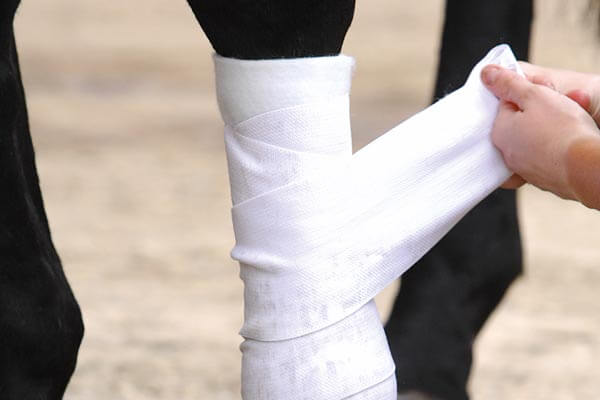
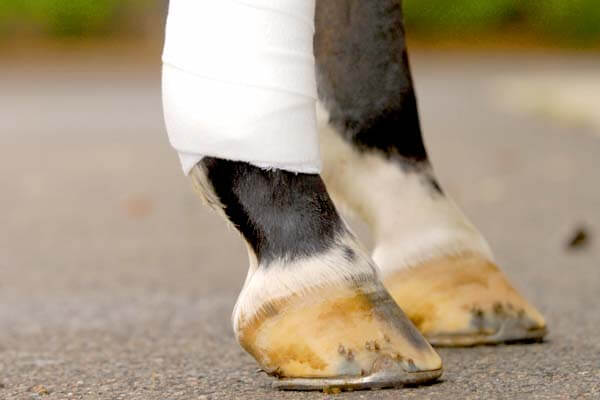
Rany z ciałem obcym
Co w sytuacji, w której rana została spowodowana przez pozostające w niej ciało obce (np. gałąź, drut)? Zdecydowanie nie warto samodzielnie go usuwać, ponieważ możemy powiększyć obszar skaleczenia oraz wywołać krwotok. Ponadto, usuwając ciało obce możemy zrobić to niedokładnie, pozostawiając zupełnie nieświadomie niewielkie fragmenty w ranie, co z pewnością będzie trudne do wyjęcia.
Uwaga!
W razie jakichkolwiek ran nie wolno podawać koniowi środków przeciwzapalnych. Wbrew pozorom nie zabezpieczy to naszego pupila przed rozprzestrzenianiem się infekcji w organizmie.
6.Kulawizna
Kulawizna, czyli reakcja konia na ból związany z problemami dotyczącymi któregoś z jego narządów ruchu.
Stopnie kulawizny:
Zauważalny wyłącznie podczas kłusa.
Widoczny podczas stępa z towarzyszącymi mu ruchami głowy (koń podnosi głowę opierając się na chorej nodze, a opuszcza stawiając kończynę na ziemi).
Koń zupełnie nie opiera się o chorą kończynę, skacząc na pozostałych.
W teorii powyższy podział jest bardzo przejrzysty, jednakże praktyka pokazuje, że rozróżnienie poszczególnych stopni wcale nie jest takie proste. Zależnie od rodzaju podłoża na którym koń jest badany, jego budowy i temperamentu - ocena stopnia kulawizny może sprawić nam spory problem. Taka sama sytuacja dotyczy określenia, która kończyna jest chora - nierzadko jest to trudnym zadaniem nawet dla doświadczonego lekarza weterynarii.
Obserwując naszego konia, warto poprosić drugą osobę o przebiegnięcie się ze zwierzęciem po linii prostej, początkowo odbiegając od nas, a następnie zawracając i biegnąc na wprost. Warto wykonać badanie zarówno na miękkim jak i twardym w miarę równym podłożu.
Warto wiedzieć, że podczas stępa koń będzie stawiał dużo dalej chorą nogę niż zdrową. Jest to spowodowane prostym faktem - koń pragnie opóźnić moment oparcia i równocześnie skrócić czas opierania się o chorą kończynę.
Jeśli nasz wierzchowiec ma problem z przednimi nogami, będzie się to przekładało na wzmożoną pracę szyi podczas poruszania się. Tak więc stawiając bolącą kończynę, koń uniesie głowę ku górze. Kiedy chora jest któraś z tylnych nóg, można to rozpoznać obserwując guzy biodrowe. Ten guz który będzie się mocniej "schodził" do środka, ta strona wywołuje ból.
Telefon do lekarza weterynarii w sprawie kulawizny
Warto rozmawiając z weterynarzem, nie tylko określić z jakim rodzajem kulawizny mamy do czynienia oraz która noga jest cierpiąca, ale także odpowiedzieć na takie pytania jak:
czy koń był ostatnio kuty bądź rozczyszczany?
czy kucie odbywało się na zimno czy na gorąco?
czy występują obrzęki, zmiany, deformacje oraz miejsca o podwyższonej temperaturze?
czy jest to "świeża" kulawizna czy długotrwała (kilka dni)?
Jeśli mamy do czynienia ze świeżym uszkodzeniem, które wystąpiło na przykład podczas jazdy, po skoku przez przeszkodę (koń uderzył się w drąg) warto przerwać jazdę i po krótkim rozstępowaniu bez jeźdźca, schłodzić bolącą nogę wodą. Jeśli noga zacznie puchnąć i zmieniać swój kształt, warto przejść do mocniejszego i długotrwałego chłodzenia.
Uwaga!
W takiej sytuacji błędem będzie wcieranie jakichkolwiek maści chłodzących czy zakładanie owijek, ponieważ zwiększy to obrzęk, pogłębiając uraz, a tym samym również i ból. Do czasu przyjazdu lekarza naszym celem powinno być zwężenie naczyń i maksymalne odprowadzanie wydzielanego ciepła. Powinniśmy więc chłodzić cierpiącą nogę zimnym strumieniem wody. Jeśli nie wiemy, która kończyna jest "uszkodzona" schłodźmy wszystkie cztery.
Po powyższym postępowaniu w dniu urazu, przez kolejne trzy dni powinniśmy również kontynuować chłodzenie, bez względu na to czy już odwiedził nas weterynarz czy jeszcze nie. W tym wypadku (zaczynając od dnia po wystąpieniu świeżego urazu) należy rozpocząć stosowanie glinki bądź maści chłodzącej.
Wykorzystaj nowe technologie podczas zgłoszenia
Warto, podczas zgłaszania problemu weterynarzowi, wykorzystać obecnie dostępne nam możliwości technologiczne. Przykładowo, zanim zabandażujesz głęboką ranę, sfotografuj ją i prześlij lekarzowi. Z pewnością w połączeniu z Twoją słowną relacją, pomoże mu to w postawieniu bardziej precyzyjnej diagnozy.
Być może, jeśli zajdzie taka potrzeba, zdecyduje on przesunąć mniej pilne zlecenia i przyjedzie prosto do Twojej stajni. W dodatku, będzie w stanie przewidzieć co powinien ze sobą zabrać do tego konkretnego przypadku i na miejscu nie zabraknie mu jakiegoś niezbędnego leku czy przedmiotu (choć zazwyczaj ambulansy weterynaryjne są jak studnie bez dna i znajduje się tam praktycznie wszystko).
Pamiętajmy jednak, że relacja słowna i zdjęcia wysłane MMSem nie wystarczą do całkowitego rozpoznania choroby, urazu bądź schorzenia. To tylko wskazówka dla weterynarza, by wiedział jaki przypadek oczekuje na jego pomoc. Do ostatecznego postawienia diagnozy niezbędna jest konsultacja na żywo!
7.Co możesz zrobić, zanim przybędzie weterynarz - podsumowanie
1. Sprawdź podstawowe parametry fizyczne konia: tętno, ilość oddechów oraz temperaturę ciała. 2. Skontaktuj się z weterynarzem, podając mu zmierzone parametry oraz niepokojące objawy. Jeśli masz taką możliwość prześlij mu zdjęcia. 3. Jeśli koń ma kolkę nie możesz mu pozwolić się tarzać, wolno z nim spacerując. Podaj mu zastrzyk dożylny lub jeśli nie czujesz się pewnie - domięśniowy z lekiem rozkurczającym. 3. Niegroźne rany naskórka - oczyść płynem fizjologicznym i odkaź. Na koniec możesz użyć środka suchego, przyspieszającego powstawanie strupa. 4. Groźne rany pozostaw niezmienione do przyjazdu weta. Jeśli czekacie na niego zbyt długo lub rana obficie krwawi, możesz przyłożyć do rany jałowy gazik nasączony płynem fizjologicznym i nań założyć opatrunek uciskowy.
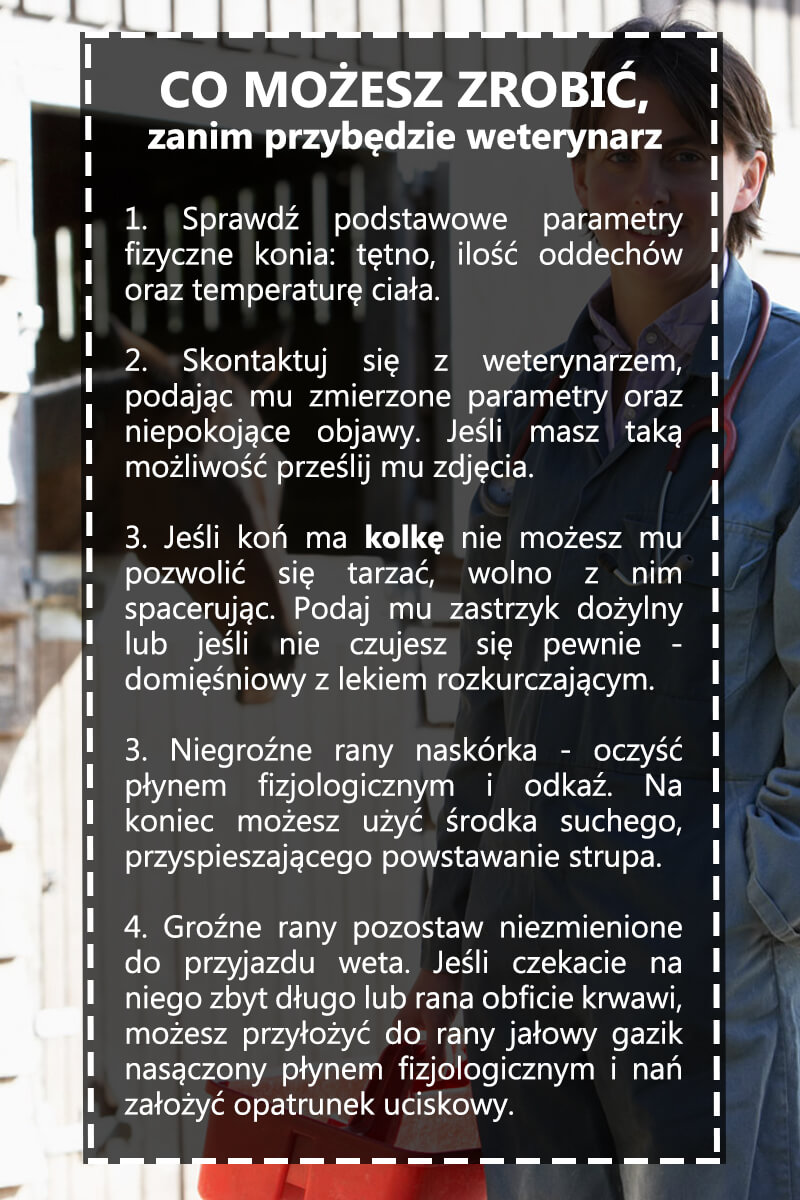
W sytuacji zagrożenia życia bądź zdrowia naszego konia nie wolno nam działać pochopnie. Jeśli nie radzimy sobie z zaistniałą sytuacją, nie wstydźmy się poprosić innych jeźdźców o pomoc. Pamiętajmy też, że samodzielne leczenie może tylko pogorszyć sytuację. Obowiązkiem każdego właściciela konia jest natychmiastowe wezwanie weterynarza i właściwa diagnostyka, gdy koń przejawia niepokojące zachowania. Samodzielnie podejmujmy jedynie działania prewencyjne, a po ostateczną diagnozę i plan kuracji zwróćmy się do lekarza weterynarii - przecież chodzi o zdrowie naszego kopytnego przyjaciela.




 źródło tła: lacollectemedicale.fr
źródło tła: lacollectemedicale.fr
![horse-therm Termometr dla konia, źródło: goodwoods.com.au [embed][/embed]](https://cdn.equishop.com/img/blog-archive-pl/2015/10/horse-therm.jpg)




















